Spas &CBeauty entres in Qatar
SPA TREATMENTS
SPA ETIQUETTE INTERESTING READS
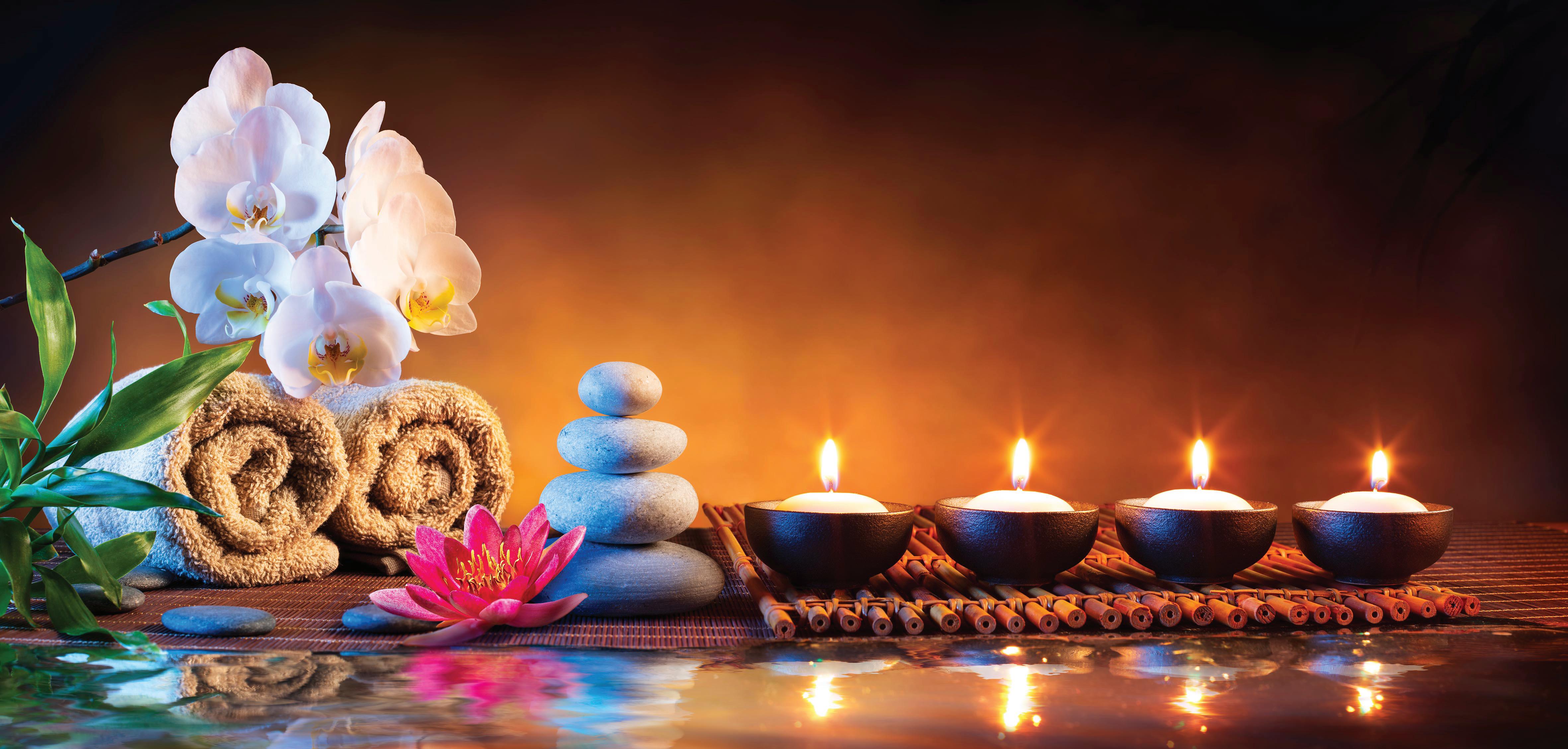
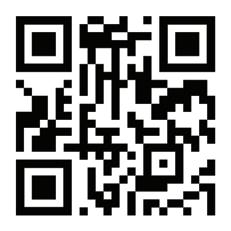
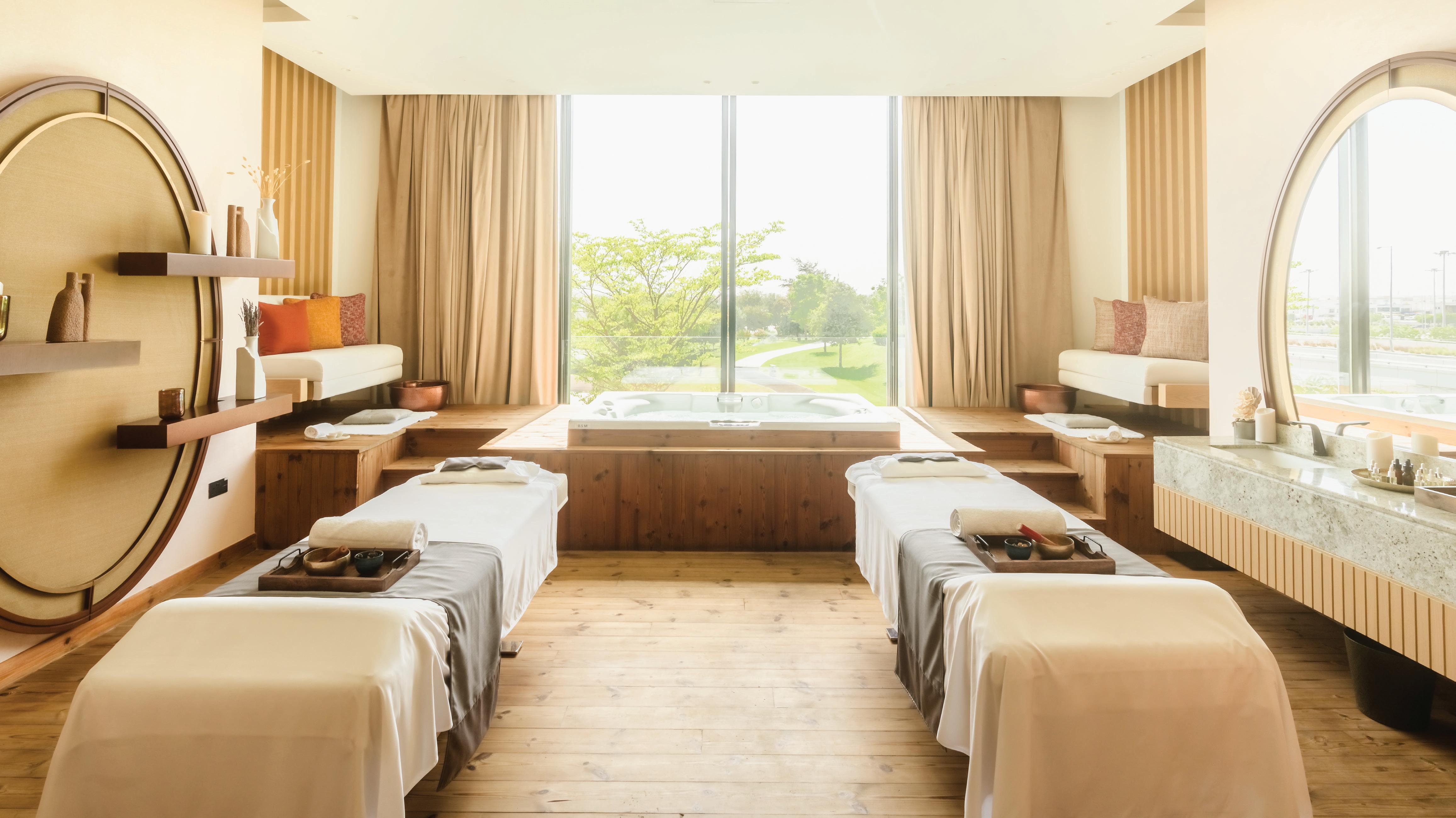

SPA TREATMENTS
SPA ETIQUETTE INTERESTING READS




Lamara Spa, a serene retreat on the 46th floor of InterContinental Doha The City, invites you to unwind with breathtaking panoramic views and abundant natural light. Discover Doha’s premier spa boutique, where bespoke treatments and state-of-the-art amenities await. Indulge in four tranquil treatment rooms, a soothing Sauna and Steam Temple, and a luxurious Hammam suite.

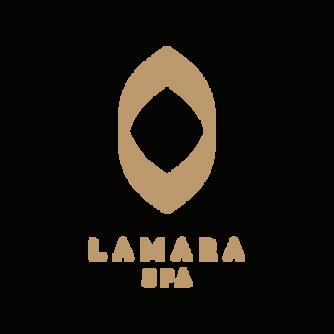


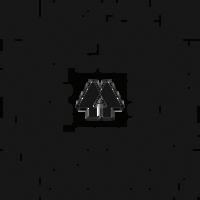
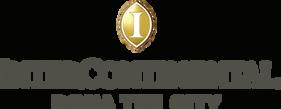
Founder & Managing Editor
Hilar y Bainbridge
Editorial
Sarah Palmer (Editor)
Ola Diab (Deputy Editor)
Terr y Sutcliffe
Adver tising
Howard Bainbridge
Marrian Magtira
Retail Sales
Ayen Molina
Online/Digital
Weslee Dizon
Patrisha Manzon
Char lotte Wright
Juggy Gill
Khaled Emad
Design and Ar twor k
Dick Tamayo
Mar Principe

Marhaba endeavours to quote accurate information and updates each of its sections every issue. However, the company accepts no responsibility or liability for any false, inaccurate, inappropriate or incomplete information presented, whether in print, on the website, or on social media channels.
© 2025 Marhaba Information Guide. All Rights Reserved. No part of this magazine may be reproduced, in any form, without written permission of the publishers.
Dana Public Relations PO Box 3797, Doha, Qatar Tel (+974) 4465 0083, 4465 5533
General Information
marhaba@marhaba.com.qa
Follow us




Ras Eshairiq Al Zubara
Suwaihliya
Soudan






By Ola Diab
Qatar’s diverse beauty scene offers a wide range of services for all, with many salons also specialising in the unique beauty traditions of different communities.
atar is a melting pot of cultures, home to more than 100 nationalities. In fact, over 80% of the country’s population consists of nonQatari residents or expatriates, largely due to the influx of migrant labourers.
Each community brings its own culture and practices, including unique beauty regimens that vary by region or country. Salons across Qatar offer all of the beauty services one could need for hair, face, and body, with staff from various parts of the world. However, there are also salons dedicated to providing specialised services tailored to the needs of specific communities.
The majority of staff and beauticians at beauty salons in Qatar come from Asia, including the Philippines, India, Nepal, Indonesia, Thailand, and more. Asian salons typically offer a full range of basic beauty treatments for the hair, body, and feet.
Indian salons, such as Shingari Beauty Center and Monalisa Beauty Centre, specialise in natural and organic scrubs using ingredients like coconut and coconut oil, aloe vera, rose water, papaya, turmeric, and tamarind, which are incorporated into various hair, body, and foot treatments. They are also well known for excellent hair threading and waxing services and are the go-to choice for henna, known as Mehndi.
In addition to the many Thai massage centres offering the ever-popular traditional Thai massages, Thai salons such as Sawasdee Beauty and Thai Spa, Thai Beauty Club, and Sabai Beauty Salon
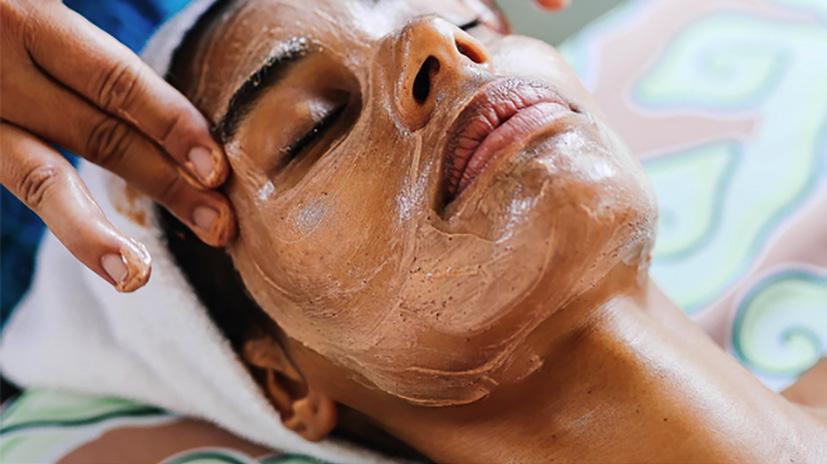
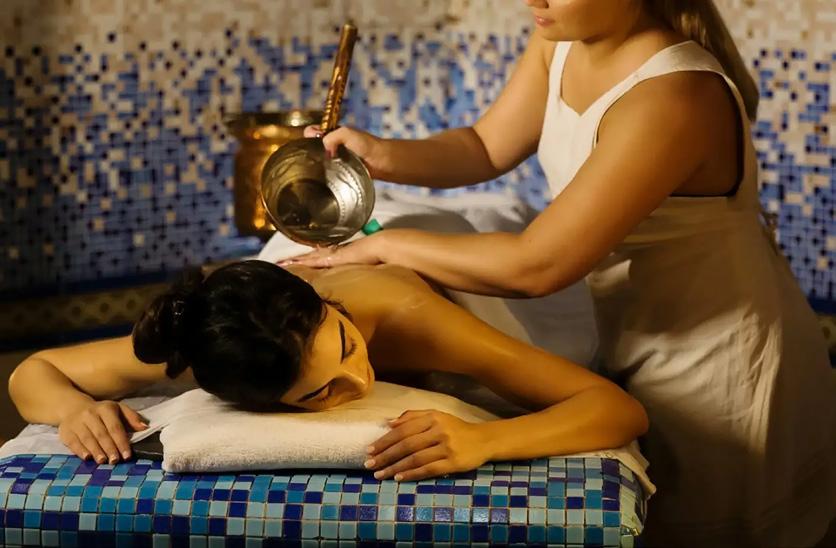
are also loved for their manicures and pedicures. They specialise in natural and organic scrubs using ingredients like coconut and coconut oil, papaya, lemongrass, turmeric, and tamarind, which are incorporated into various hair, body, and foot treatments.
Filipino beauty centres, such as La Diva De Quafeir Beauty Center, are known for their expertise in hair services, including colouring, cutting, styling, and more.
Catering to African women, African salons such as EmbellieQatar, Pambo Beauty Salon Qatar, and Mama Africa Beauty Salon Qatar specialise in textured and curly hair – often referred to as Black hair – offering braids, dreadlocks, cornrows, weaves, extensions, wigs, locks, twists, colouring, perms, blowouts, cuts, and more. Beyond hair care, these salons also provide services like manicures, pedicures, waxing, massages, and other beauty and spa treatments.
For the Sudanese community, salons such as Sudanese Touches (Lamasat), Al Adeel W Al Zain Salon, Sandalwood Ladies Salon, and others offer traditional Sudanese beauty regimens, including black henna (a mix of dye and henna powder) and dukhan – an incense-infused smoke bath where women sit over a pit of burning Acacia wood, covered with a blanket or heavy fabric, for 30 minutes to 1.5 hours. This treatment is believed to detoxify the skin, relieve rheumatic pain, and aid in wound healing. It can be done as a one-time session or as part of a shedding treatment. These salons also provide exfoliating




body scrubs like dilka and aruka, which are used to soften and lighten the skin, removing impurities and dead skin cells. These beauty practices are usually performed by married women or brides, for whom the salons offer special packages.
Similar to African salons, Sudanese salons cater to textured and curly hair, offering services such as braiding, extensions, colouring, perms, blowouts, cutting, hair straightening (relaxers), and more.
For the Ethiopian community, salons like Habesha Beauty Center also specialise in services for textured and curly hair, including braiding, straightening, curling, relaxing, and other hair treatments.
From the Middle East and North Africa (MENA) region
If you're looking for Arab salons, you’ll find Moroccan, Lebanese, and Egyptian salons – each offering their own special beauty regimens: Moroccans with their famous Moroccan bath or hammam, Lebanese known for expert hair styling, and Egyptians with their traditional halawa waxing.
Arab salons such as Al Mashata Beauty Centre & Spa offer a wide array of beauty, wellness, and rejuvenation services, including waxing, tanning, slimming treatments, makeup, facials, manicures, pedicures, body treatments, and more.
One of the most popular types of beauty salons in Qatar are Moroccan salons, like Moroccan Touches (Lamasat Maghribiya), largely due to the famous Moroccan bath or hammam, which has become a

staple in many beauty salons and spas – even those catering to other communities. Morocco is renowned for its natural beauty products, and essential oils, floral waters, and other mixtures such as Argan oil, Moroccan black soap (sabon beldi or savon noir), and rhassoul clay are especially sought after.
There are also Lebanese beauty salons, including Maison de Joelle Beauty Salon & Spa, run by Lebanese celebrity makeup artist Joelle Mardinian, and Yehïa & Zakarïa Beauty Salon, founded by Lebanese brothers and celebrity hairdressers Yehïa and Zakarïa.
Egyptian salons such as Marhaba Beauty Salon and Jawana Beauty Salon offer a variety of hair and body services, including Egyptian halawa waxing – also known as Arabic wax or Arabic sugar wax, or sugaring – which is made from a mixture of sugar, lemon, and water.
From Europe, America and the rest of the world Qatar is also home to salons owned and operated by Americans, British, and other nationalities. These include Desert Princess (British), Roots Hair & Beauty Salon (British), and Kozma & Kozma Salon Qatar (American) – all award-winning salons offering a full range of beauty services, with a special focus on hair and nail treatments.
There’s also Fadia El Mendelek Beauty Salon, led by Swedish-certified hairstylist and makeover expert Fadia El Mendelek. From the UK, TONI&GUY, an iconic British multi-award-winning hairdressing superbrand with Italian flair, is internationally renowned for its acclaimed stylists. m
In addition to independent salons, there are salons in hotels that cater to all. See Spas and Beauty Centres in the Hospitality, Hotels and Dining section.
Note: Beauty salons in Qatar are exclusively for women; men are not allowed. There are separate salons specifically for men. However, some beauty salons located in hotels cater to both men and women and may offer treatments for married couples.



With the ever-increasing number of spas in Qatar, it is no surprise that a huge variety of treatments are available.
For those uninitiated in the spa lifestyle this wide variety can be daunting and may cause unnecessary stress – exactly what a visit to the spa should be alleviating!
This stress can be easily overcome with this guide on different treatments, as well as their history. Hopefully this will help guide your choice as to what treatment is right for you.
Spas are well equipped with state-of-the-art facilities and many offer membership packages which can reduce the cost of treatments. Membership may also allow access to the beach, swimming pools and gymnasiums, for a full day of R&R. Regardless of whether you are visiting the spa under a membership or as a guest, you will be given first-class treatment and the use of lockers, changing rooms and showers. Some spas have comfortable seating areas where you can relax before or after a session, while enjoying healthy food and drinks. The in-depth information, plus some interesting related articles, should help you in selecting which spas are best suited for your requirements.


Spa’s and Beauty
Centres
Choose Your Spa!
Spa Etiquette
Spa Treatments
Hot stone therapy
Swedish massage
Thai massage
Morrocan or Turkish Hammam
Aromatherapy
Reflexology
Features
Spa Facilities
Sauna
Steam room
Continuing Your Relaxation Colour Therapy
Visiting the Spa while Pregnant
Traditional Healing Modern Beauty and Wellness Treatments
Real Men Goes to Spa, Too
Cupping Therapy
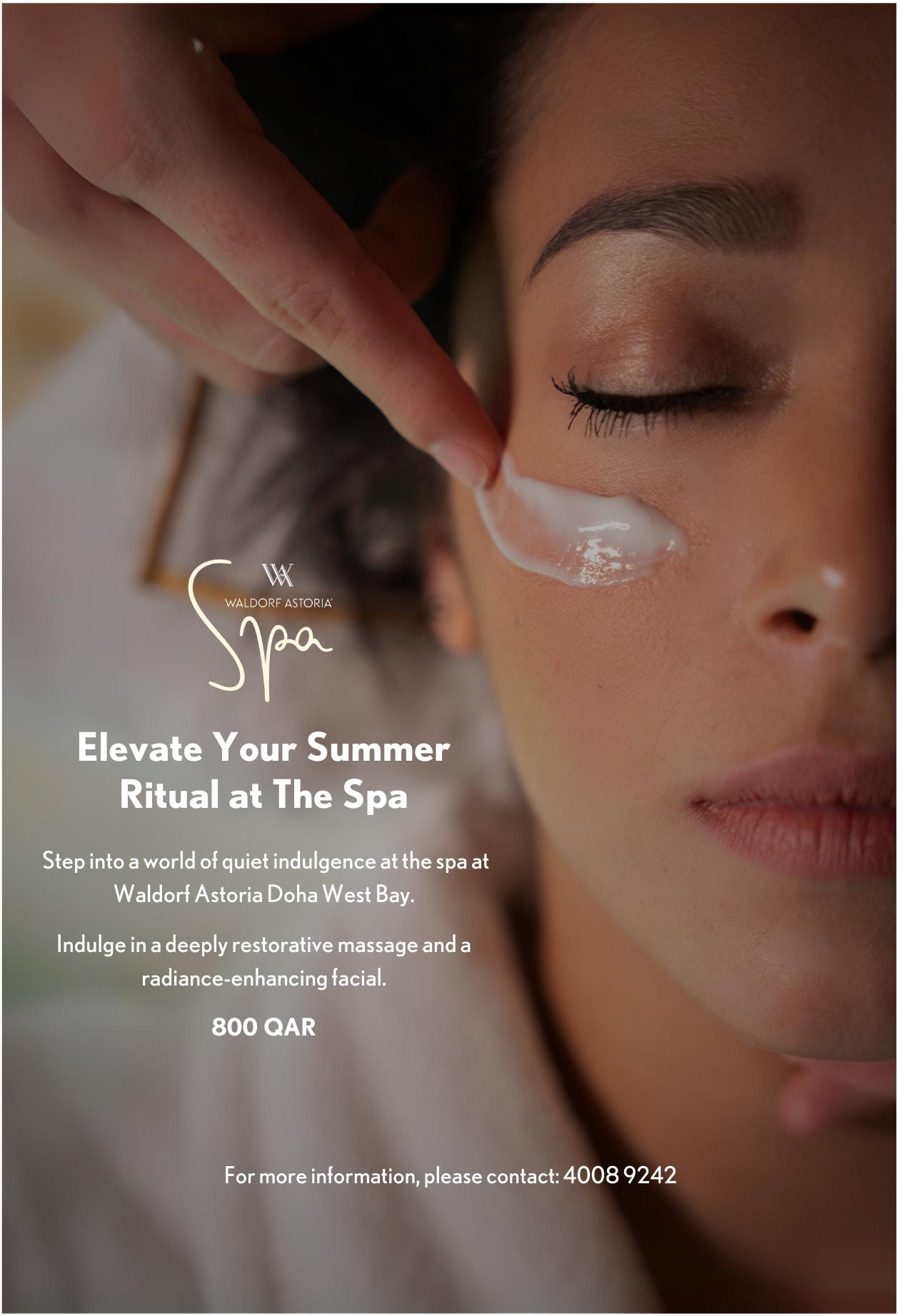


AIO, The OQ 7005 9401
Anantara Spa, Banana Island Resort Doha 4040 5158 anantara.com
Anjana Spa, Rixos Gulf Hotel Doha 4429 8555 D4 rixos.com/en/rixos-gulf-doha-anjana-spa
Banyan Tree Spa Doha 4410 3314 D4 banyantree.com
Cabana Club at Radisson Blu Hotel, Doha 4428 1622 D4
eforea Spa, Hilton Doha 4423 3441 C4 hilton.com
ESPA at Mondrian Doha 4045 5550 B4 mondriandoha.com
ESPA Life, Waldorf Astoria Doha Lusail 4456 5656 A4 waldorfastorialusaildoha.com
GOCO Spa, Steigenberger Hotel Doha 4020 1625 D4 steigenberger.com
Heavenly Spa, The Westin Doha Hotel & Spa 4492 1682 D4 heavenlyspadoha.com
Katara Hills LXR Spa 4402 4319 B4 hilton.com/en/hotels/dohqkol-katara-hills-doha
Lamara Spa, InterContinental Doha The City 4015 8664 C4 dohawestbay.intercontinental.com/en/lamaraspa
La Vallee Spa Switzerland, Le Royal Meridien Place Vendome 4141 6210 A4 leroyalmeridiendoha.com
Lotus Flower Spa at Delta & Element by Westin 4470 3333 C3 marriott.com
Marsa Malaz Spa, Marsa Malaz Kempinski 4035 5555 A4 kempinski.com/en/doha
M|SPA, Alwadi Hotel Doha – MGallery 4009 9999 D4 alwadihoteldoha.com/spa-fitness/m-spa
Naturelife Spa, Rixos Premium Qetaifan Island North 4144 4444 A4 naturelifespa.com
Our Wellness, Our Habitas 4023 0666 ourhabitas.com/ras-abrouq/ Pullman Doha West Bay 4009 4090 C4 pullman-doha-westbay.com
Quan Spa, JW Marriott Marquis City Center Doha 4429 5118 C4 marriott.com
Raffles Spa, Raffles Doha 4030 7100 A4 raffles.com/doha/spa
Saray Spa, Marriott Marquis City Center Doha Hotel 4419 6090 C4 sarayspadoha.com
Sharq Village Spa 4425 6999 D4 spa.sharqvillagedoha.com
Sisley Paris Spa, W Doha Hotel & Residences 4453 5555 B4 marriott.com
Spa & Wellness Centre, Four Seasons Hotel Doha 4494 8802 C4 fourseasons.com/doha/spa
The Ned’s Club Spa 4406 1111 D4 thened.com/doha/spa-and-grooming
The Opal Spa, Steigenberger Hotel Doha
hrewards.com
8174 A4 ritzcarlton.com/en/hotels/qatar/doha/spa The Spa at Mandarin Oriental, Doha
8711 D4 mandarinoriental.com/doha The Spa at Maysan Doha, LXR Hotels & Resorts

6680 D2 hilton.com/en/hotels/dohpaol-maysan-doha The Spa at Park Hyatt Doha
6290 D4 parkhyattdoha.com The Spa at Souq Waqif Boutique Hotels
The Spa at The Chedi Katara Hotel & Resort
Waldorf Astoria Spa, Waldorf Astoria West Bay Doha
6878 D4 tivolihotels.com/en/souq-waqif-doha
7775 B4 chedikatara.com
9242 C4 hilton.com Zulal Serenity & Zulal Discovery
SITE

✔ ✔ ✔ ✔ ✔ ✔ ✘ ✔ ✔ ✘ ✔ ✔ ✔ ✔ ✔ ✔ ✔ ✔ ✔ ✔ ✔ ✘ ✔ ✔ ✔ ✔ ✔ ✔ ✔ ✘ ✘ ✔ ✘ ✘ ✔ ✘ ✔ ✔ ✔ ✔ ✔ ✘ ✔ ✔ ✘ ✔ ✔ ✘ ✔ ✔ ✔ ✔ ✘ ✘ ✘ ✘ ✘ ✘ ✘ ✘ ✔ ✔ ✔ ✔ ✔ ✔ ✘ ✔ ✘ ✔ ✔ ✔ ✔ ✔ ✔ ✔ ✔ ✔ ✔ ✔ ✘ ✘ ✔ ✘ ✔ ✔ ✔ ✔ ✔ ✔ ✔ ✔ ✘ ✔ ✔ ✔ ✔ ✔ ✔ ✔ ✔ ✔ ✘ ✔ ✘ ✘ ✔ ✘ ✔ ✔ ✔ ✔ ✔ ✔ ✘ ✔ ✘ ✔ ✔ ✔ ✔ ✔ ✔ ✔ ✔ ✔ ✘ ✔ ✘ ✔ ✔ ✘ ✔ ✔ ✔ ✔ ✔ ✘ ✘ ✔ ✘ ✔ ✔ ✘ ✔ ✔ ✔ ✔ ✔ ✘ ✔ ✔ ✘ ✘ ✘ ✘ ✔ ✔ ✔ ✔ ✘ ✘ ✘ ✔ ✘ ✘ ✔ ✘ ✔ ✔ ✔ ✔ ✔ ✔ ✘ ✔ ✘ ✔ ✔ ✘ ✔ ✔ ✔ ✔ ✔ ✘ ✘ ✔ ✘ ✘ ✘ ✘ ✔ ✔ ✔ ✔ ✘ ✘ ✘ ✔ ✘ ✘ ✘ ✘ ✔ ✔ ✔ ✔ ✔ ✔ ✘ ✔ ✘ ✘ ✘ ✘ ✔ ✔ ✔ ✔ ✔ ✔ ✔ ✔ ✔ ✘ ✘ ✘ ✔ ✔ ✔ ✔ ✔ ✔ ✔ ✔ ✔ ✔ ✘ ✘ ✔ ✔ ✔ ✔ ✔ ✔ ✔ ✔ ✘ ✘ ✔ ✘ ✔ ✔ ✔ ✔ ✔ ✔ ✘ ✔ ✘ ✔ ✘ ✘ ✔ ✔ ✔ ✔ ✔ ✔ ✔ ✔ ✔ ✘ ✘ ✘ ✔ ✔ ✔ ✔ ✔ ✔ ✔ ✔ ✘ ✔ ✔ ✔ ✔ ✔ ✔ ✔ ✔ ✔ ✔ ✔ ✔ ✔ ✔ ✔ ✔ ✔ ✔ ✔ ✔ ✘ ✘ ✔ ✘ ✔ ✔ ✘ ✔ ✔ ✔ ✔ ✔ ✔ ✘ ✔ ✘ ✘ ✔ ✔ ✔ ✔ ✔ ✔ ✔ ✘ ✘ ✔ ✔ ✘ ✔ ✘ ✔ ✔ ✔ ✔ ✔ ✘ ✘ ✔ ✘ ✔ ✔ ✔ ✔ ✔ ✔ ✔ ✔ ✔ ✘ ✔ ✘ ✔ ✔ ✘ ✔ ✔ ✔ ✔ ✔ ✔ ✔ ✔ ✔ ✔ ✔ ✘ ✔ ✔ ✔ ✔ ✔ ✔ ✘ ✔ ✘ ✘ ✘ ✘ ✔ ✔ ✔ ✔ ✔ ✔ ✘ ✘ ✘ ✘ ✔ ✔ ✔ ✔ ✔ ✔ ✔ ✔ ✔ ✔ ✘ ✔ ✔ ✘ ✔ ✔ ✔ ✔ ✔ ✔ ✔ ✔ ✔ ✔ ✔ ✔


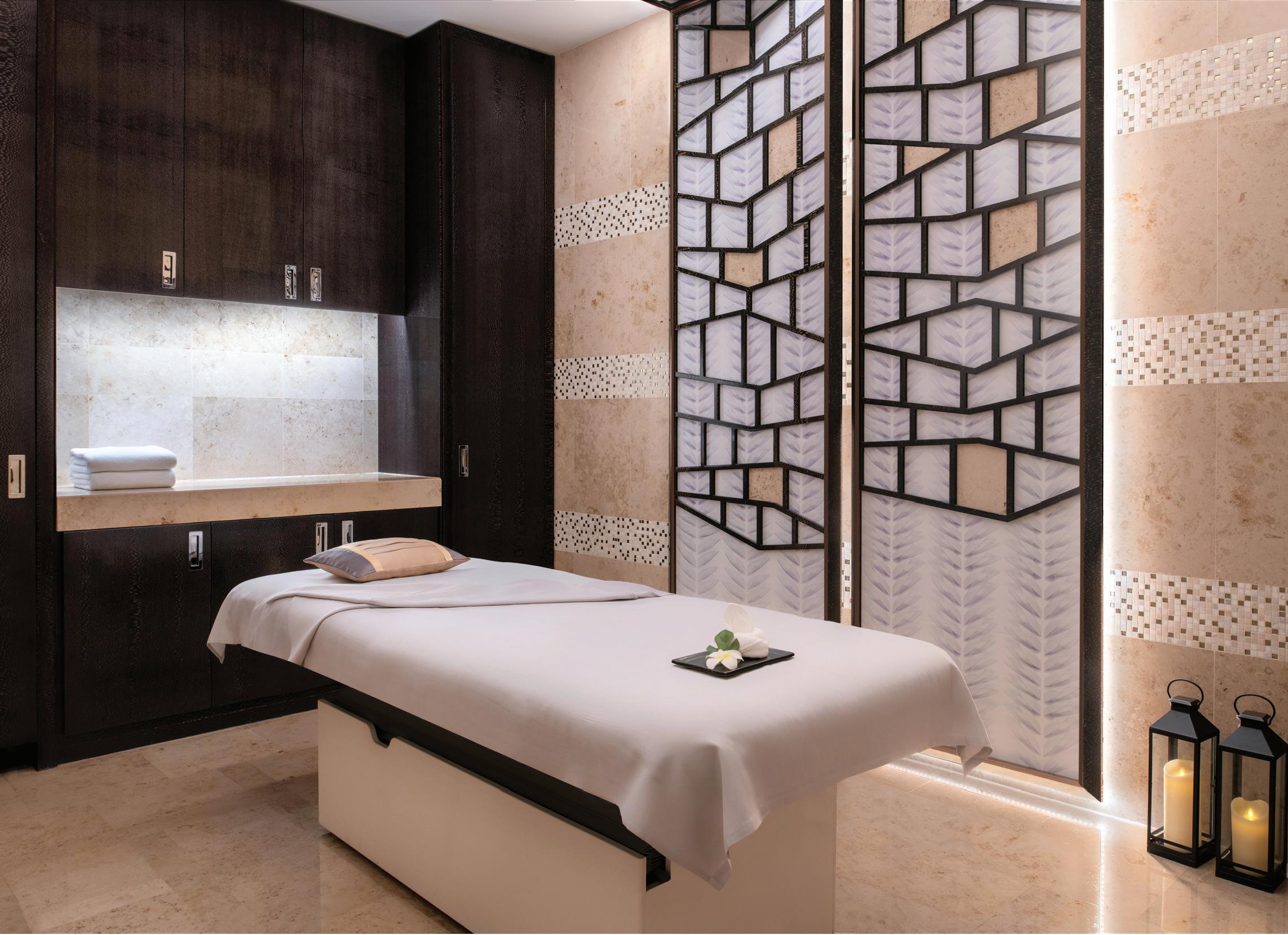
A unique facial for those seeking to gain optimum results, combining LED light therapy, with the innovative TFC8®, the powerful and groundbreaking ingredient by Augustinus Bader. The skin is rejuvenated and highly regenerated. A stimulating scalp massage including the Augustinus Bader Scalp Treatment rounds up this service excellence facial.
For more information, visit www.ritzcarlton.com/doha or call +974 4484 8173
ritzcarltondoha
©2024 The Ritz-Carlton Hotel Company, L.L.C.



Aldo Coppola, Park Hyatt Doha 3118 9982 D4 parkhyattdoha.com
Desert Princess, Ain Khaled branch 4486 4169 E3 desertprincessdoha.com
Elie & Ralph Beauty Salon, InterContinental Doha 3363 5678 B4 elieandralph.com
Fadia El Mendelek, The Ritz‑Carlton, Doha 4417 7755/66 A4 fadiaelmendelek.com.qa
Franck Provost, Four Seasons Hotel Doha 4494 8844 C4 fourseasons.com/doha/spa
Heavenly Beauty, The Westin Doha Hotel & Spa 4492 1682 D4 heavenlyspadoha.com
Jaula Spa & Club Salons, Grand Hyatt Doha 4448 1235 B4 doha.grand.hyatt.com
Jean Louis David, Marriott Marquis City Center Doha Hotel 4417 5771 C4 andtrading.net
Kozma & Kozma, Salwa Road 6686 4220/1 D3 kozmaandkozma.com West Bay Lagoon (for all salons) B4
Luce Giovani, InterContinental Doha The City 4015 8666 B4
N.Bar, The Gate Mall
Nails, Ezdan Mall
6408 C4
2252 F5 andtrading.net
C4
Pearl Island 4481 2316 B4
Pace e Luce, The St. Regis Doha 6612 6650 B4 paceeluce.com
Patrice Alexandre, The Gate Mall 4407 7107 C4 patricealexandre.net
Pour Elle, Radisson Blu Hotel, Doha 4428 1740 D3/4 Roots Hair and Beauty 4411 4463 C3 rootshair.net
Sabit Akkaya Ladies’ Hair and Beauty Salon 5566 4710 D4 mandarinoriental.com/doha
Sabit Akkaya Men’s Grooming Lounge 5566 4710 D4 mandarinoriental.com/doha
Skin and Soul (ladies), Sheraton Grand Doha 4485 3840 C4 skinandsoul.com.qa
Skin and Soul (men), Sheraton Grand Doha 4485 4840 C4 skinandsoul.com.qa
The Barber Shop Doha, Four Seasons Hotel Doha 6616 0349 C4 andtrading.net Marriott Marquis City Center Doha Hotel 4483 0623 C4
Wispy Hair by Riad, Dusit Doha Hotel 4004 4303 C4

Foot Care Centre, City Center Doha 4436 6275 C4 ebnsina.com.qa Int’l Chinese Body Care Houses, Mirqab Mall 4411 5728 D3 icbodycare.com

✔ ✔ ✘ ✘ ✘ ✘ ✘ ✘ ✘ ✔ ✔ ✔ ✔ ✘ ✘ ✘ ✘ ✘ ✘ ✘ ✘ ✔ ✔ ✔ ✔ ✘ ✘ ✘ ✘ ✘ ✘ ✘ ✘ ✔ ✔ ✘ ✔ ✘ ✘ ✘ ✘ ✔ ✘ ✘ ✘ ✔ ✔ ✔
✔ ✘ ✔ ✔ ✔ ✔ ✘ ✘ ✔ ✔ ✔ ✔ ✔ ✘ ✔ ✔ ✔ ✔ ✘ ✘ ✔ ✔ ✔ ✔ ✔ ✔ ✘ ✘ ✘ ✘ ✘ ✘ ✘ ✔ ✔ ✔
✔ ✘ ✘ ✘ ✘ ✘ ✘ ✘ ✘ ✔ ✔ ✔ ✔ ✘ ✔ ✘ ✔ ✘ ✘ ✘ ✘ ✔ ✔ ✔ ✔ ✘ ✔ ✘ ✔ ✘ ✘ ✘ ✘ ✔ ✔ ✔
✔ ✘ ✔ ✘ ✔ ✘ ✘ ✘ ✘ ✔ ✔ ✔
✔ ✘ ✘ ✘ ✘ ✘ ✘ ✘ ✘ ✔ ✔ ✔ ✘ ✔ ✘ ✘ ✔ ✘ ✘ ✘ ✘ ✔ ✔ ✔
✔ ✘ ✘ ✘ ✘ ✘ ✘ ✘ ✘ ✔ ✔ ✔ ✔ ✘ ✔ ✘ ✔ ✘ ✘ ✘ ✘ ✔ ✔ ✔ ✔ ✘ ✘ ✘ ✘ ✘ ✘ ✘ ✘ ✔ ✔ ✔ ✘ ✔ ✘ ✘ ✘ ✘ ✘ ✘ ✘ ✔ ✔ ✔
✔ ✘ ✔ ✘ ✔ ✘ ✘ ✘ ✘ ✔ ✔ ✔ ✘ ✔ ✔ ✘ ✔ ✘ ✘ ✘ ✘ ✔ ✔ ✔ ✘ ✔ ✘ ✘ ✘ ✘ ✘ ✘ ✘ ✔ ✔ ✔


Sabit Akkaya Ladies’ Hair and Beauty Salon, Mandarin Oriental
Read more in our Spa e‑guide –just scan the QR code below!
✘ ✔ ✘ ✘ ✘ ✘ ✘ ✘ ✘ ✔ ✔ ✘ ✔ ✘ ✘ ✘ ✘ ✘ ✘ ✘ ✘ ✔ ✔ ✔ Checked & Updated February 2025


The modern-day spa is a nurturing, safe and clean environment, a serene atmosphere with professional, licenced aestheticians and therapists – it should, in essence, embrace everything that can relax and energise you. Saunas, steam rooms, Jacuzzis and hydrotherapy are available in conjunction with a range of massages, aromatherapy, reflexology, body and beauty treatments.
Whereas a health or fitness club will focus on physical wellbeing, the spa works on the mind, body and spirit, aiming for both inner and outer wellbeing. For some, visiting the spa may be something of a mystery: What is on offer, is there something you need to do to prepare for a visit, what do you wear? This spa guide aims to demystify the spa experience and encourage you to pursue pampering and relaxation.
• A locker will be provided for your personal belongings, together with use of showers, a vanity area, hairdryers, etc.
• A spa should never compromise your modesty. You will be given a robe to change into before treatment and you may be asked to remove your clothes (except underwear).
• A therapist will only expose the specific parts of your body that is being treated at that time and will ensure that you remain covered in a dignified manner at all times.
• A full body massage does not include any parts of the body which you may feel embarrassed about or which are painful/injured; areas to avoid should be discussed with your therapist beforehand.
• For hydrotherapy, sauna or steam room, you will need to bring a swimsuit and flip flops.


• Aim to arrive at least 30 minutes before a treatment so that you have time to change and relax. If visiting for the first time, you will likely be asked to complete a quick questionnaire to mention injuries, health issues, allergies, etc.
• Make-up may be worn but is best removed during certain treatments. Likewise head massages may involve oils, so bring your make-up bag and hair products if you want to retouch before leaving.
• It is recommended that you eat a light meal before a treatment and drink plenty of water afterwards to rehydrate and to flush out any toxins.
• If your therapist’s touch is too rough, then mention it. They are there for you and their goal is to provide you with a perfect spa experience.
• There is no pressure to talk during a treatment. If you have questions or would like to chat during the session certainly do so. The therapists will take their cue from you. If you are quiet, they will be too. Falling asleep is not a problem – a therapist will take that as a compliment!

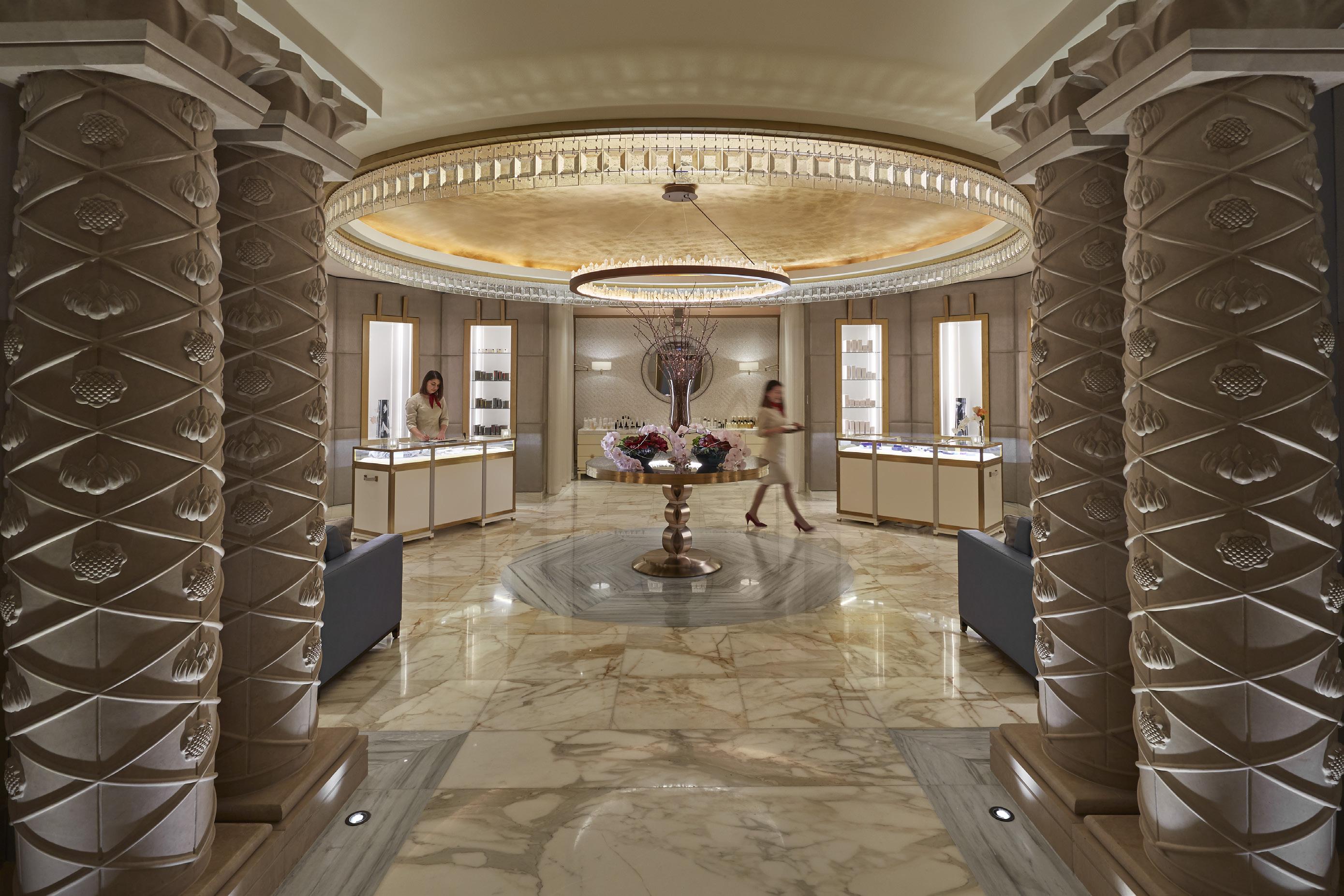
The Spa at Mandarin Oriental, Doha, offers a holistic approach inspired by ancient Oriental philosophy, focusing on the mind, body and soul.

By Ola Diab
The beauty and wellness industry in Qatar has advanced with innovative treatments, offering non-invasive options for weight loss and body shaping.
The business of beauty and wellness is ever-evolving and in recent years, and has advanced tremendously with the introduction of advanced devices that have introduced new treatments and even developed traditional ones.
In today’s image-obsessed world, there are now many treatments that help with weight loss and body shaping that are non-invasive or non surgical.
Some treatments can be found at spas, beauty and wellness centres. Some are provided by body therapists who provide home services. However, when seeking a treatment – whether at spa, beauty or wellness centre or a home service, ensure both are licensed. The Ministry of Commerce and Industry (MOCI), along with the Ministry of Public Health (MoPH), oversee spa, beauty or wellness businesses in Qatar, and impose strict health and safety rules and regulations that businesses and their employees have to adhere to.
Here are modern body massages and treatments that can be found in Qatar:
Anti-cellulite massage
Anti-cellulite massage is designed to reduce and combat cellulite over a period of continued therapy. A special massage technique is used to massage the bulging fat and knead the muscles and 'roll' the fat away thereby combating the physical cause of cellulite – bulging fat and stretched collagen strands. A massage therapist has to have special qualifications and certifications to perform the anti-
Anti-cellulite massage works by breaking down the underlying fat in the areas affected by cellulite, using special techniques of pinching and rolling to break down the fat. The massage therapist usually begins by working the hips, thighs, legs and feet to ‘activate’ the areas. This activation process increases blood circulation, thereby accelerating the recovery process, and the flow of energy throughout the body. The activation process will feel similar to a normal massage. However, unlike a full body massage, the therapist primarily focuses on the areas with cellulite during the entire duration of the massage. The areas with cellulite tend to be sore and painful at times so it is common to experience some discomfort during the massage.
Maderotherapy, also known as wood therapy, is a treatment that uses pieces of wood to massage the body. The therapist will use different strokes and pressure to target specific areas, depending on the client’s needs.
Maderotherapy uses different wooden instruments to manipulate the skin, tissue and muscles. The tools used vary from rollers, spheres, and sculpting tools that select the specific areas to work on.
The therapist can adjust the pressure used to suit each client’s needs. The wooden instruments are used to massage, drain and sculpt specific areas of the body. Through the application of wooden elements, a therapist reaches deep down to the skin cells, which enables facial remodelling and the activation of fibroblasts that produce more collagen




and elastic fibres. Certain movements affect the muscle tissue, circulatory and lymphatic system, all of which increase the supply of nutrients and oxygen to the cells.
Maderotherapy is a facial and body treatment. The benefits of facial maderotherapy include facelift effect, prevents facial aging, improves oxygenation, accelerates circulation, reduces wrinkles, improves skin tone and eliminates under eye swelling. The benefits of body maderotherapy has several benefits, including cellulite reduction, pain management, stiffness, relaxation, weight loss, chronic pain, lymphatic drainage and inch loss.
Lymphatic drainage massages
Brazilian lymphatic drainage massage (BLDM)
BLDM is a mix of relaxation and body sculpting and a specialised type of massage therapy that focuses on stimulating the lymphatic system to promote the removal of excess fluid and toxins from the body.
BLDM is a full body treatment that combines light and slow movements in certain parts of the body with rhythmic movements and more pressure in others, with the objective of the body in areas of greater concentration of localised fat and improving the appearance of cellulite, and accentuating the natural curves of the body. BLDM can also improve
skin tone and texture by promoting circulation and reducing puffiness, potentially leading to a more radiant complexion.
Lymphatic drainage massage
Also known as Manual Lymphatic Drainage (MLD) and lymphatic massage (Manual), the lymphatic drainage massage is a technique developed by the Vodders (Dr Emil Vodder and his wife, Estrid) in 1936 in Paris for treatment of swollen lymph nodes. Lymphatic diseases, especially lymphoedema, represent a serious problem in the health community.
The lymphatic drainage massage is a light, skinstretching massage that helps promote the movement of lymphatic fluid out of the swollen limb. It should not be confused with a traditional massage. The massage is specifically focused on the lymph vessels to help the flow of lymphatic fluid. Therapy is applied to your unaffected areas first, making it possible for the fluid to move out of the affected area, or ‘decongest’ the region. The massage helps open the remaining functioning lymph collectors and move protein and fluid into them, as well as to help speed up lymph fluid flow through the lymphatics.
Unlike BLDM, the lymphatic drainage massage uses only light and very slow movements. In addition,

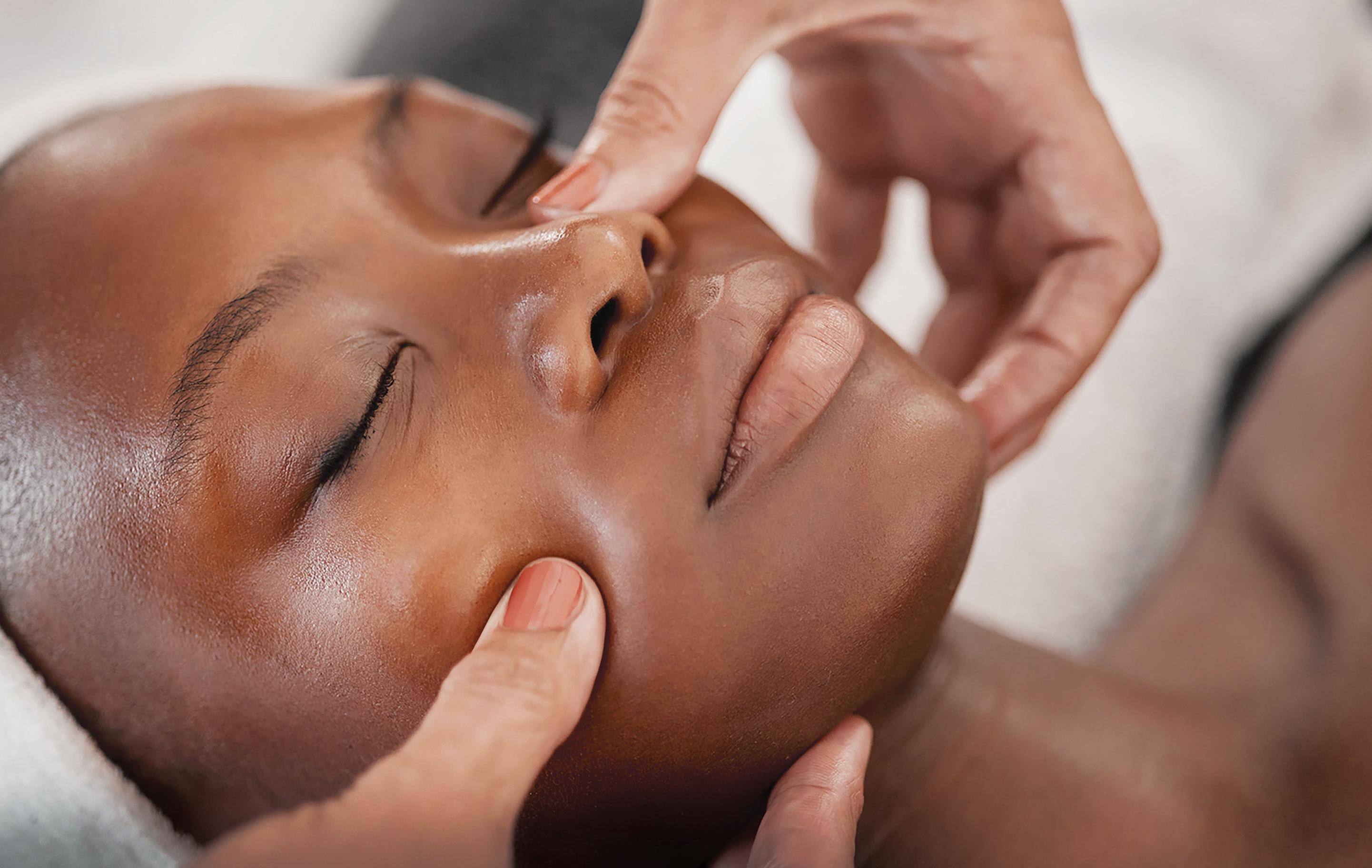


unlike BLDM, the lymphatic drainage massage can also be applied to the face.
Face lymphatic drainage massage, also known as lymph drainage massage facial, is a light touch massage on the face, neck and chest areas. It is a powerful healing tool for many health ailments and skin conditions. The intention is to stimulate the lymph vessels that run just below the skin. The lymphatic system drains excess interstitial fluids from tissues and is a vital part of your immune system. This means the facial can stimulate your immune system during and after times of illness and can help in many cases of allergies, sinusitis, puffiness around the eyes and minor health issues. The gentleness of the treatment will lull you into a state of deep calm and relaxation, further enabling your body to heal and repair.
EMsculpt Neo Body Sculpting Treatment
EMsculpt® is the world’s first treatment which helps patients build muscle and sculpt their bodies, non-invasively. A first-of-its-kind, the cutting-edge

20,000 crunches or squats in half an hour.
This 30-minute procedure is performed twice a week for four to six sessions, and you can return to your normal activities immediately after each session.
Usually, a post-treatment massage is performed. The massage consists of circular motions and vigorous kneeding. This is to help the body to continually breakdown the fat cells. It is estimated that this massage can improve results by 60% or more.
Icoone treatments
Icoone is a non-surgical body sculpting treatment, which works by using a combination of mechanical stimulation, laser contouring, and LED to break down fat cells. Using Roboderm technology, it is a solution for skin imperfections. The device is equipped with different treatment heads fitted with rollers. Each of them has hundreds of microalveoli which provide a multidimensional stimulation massage (1,180 micro stimulations per dm2 at each pass).

Icoone treatments are women and men who are looking for a quick, effective and noninvasive solution for a number of therapeutic and aesthetic problems. Icoone facial treatment is a unique treatment for neck, face, cleavage, eyes and lips. It gives the lift effect without the use of needles and scalpel. Icoone body treatment eliminates local adiposity, saggy skin, post baby belly, cellulite, and lymphoedema and makes the body slim and firm using multi micro alveolar stimulation (MMAS), which is intended not only for large areas (Robosolo handpiece), but also to provide a massage to delicate skin areas such as face, neck and chest. Robomini and Robomikro treatment heads smoothen and firm the skin, improve the shape of

to cure vascular and lymphatic diseases, preand post-surgery/liposuction, reduces scars and burn marks, decreases muscular pain, improves functional rehabilitation, and offers neurosensory stimulation.
See Spas and Beauty Centres for our listings or visit marhaba.qa/our-partners-spas-beauty-centres

Buccal massage: An advanced face massage that stimulates the various muscles of the face. The therapist massages the face from the inside out, by putting her hands inside the mouth and accessing all the muscles of the cheeks, lips and jawline areas. It’s an incredible technique that works profoundly and simultaneously on the inside and the outside of the face, allowing the practitioner to access deeper layers of ligaments and muscle tissue.
The specific movements of the massage help remove tension and blockages, and by stretching, relaxing and strengthening select muscles, which retrains a more natural facial posture. It helps to detoxify, as there are many lymph nodes in the cheeks, jaw and neck, de-puff eyes and sagging skin, and improve muscle elasticity. Face yoga, face gym, face fit: There are many names for non-invasive facial treatments that involve performing various exercises and massages targeted at not only deeply cleansing impurities for a clearer complexion, but also toning and tightening the facial muscles and lifting and contouring tge face. They are collagen-boosting and muscle training exercises for the face, which at times, can involve advanced technology and tools. Some basic facial exercises can be found online and practiced in your free time.


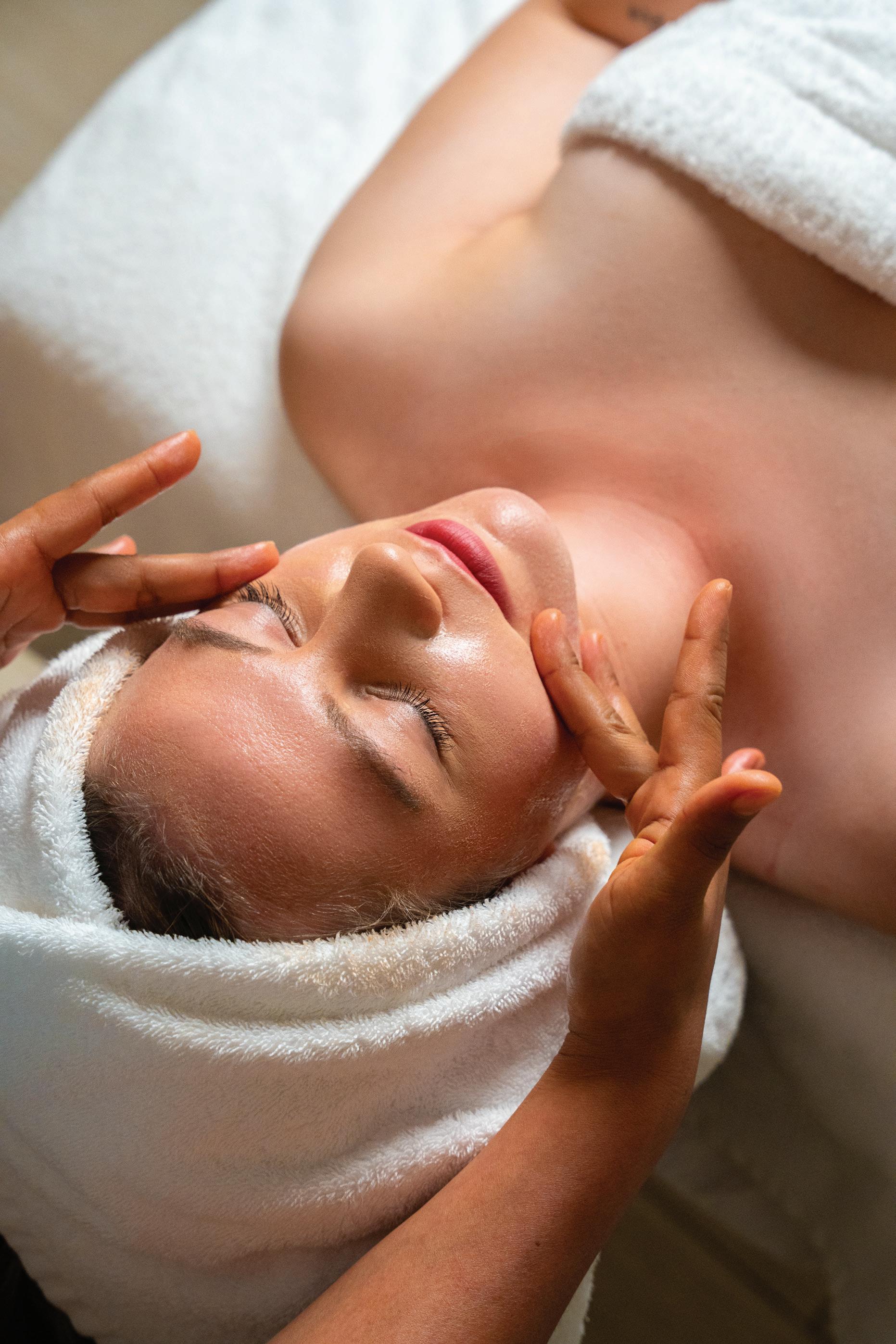


The spa is normally indulged by women with busy work-a-day lives and multitasking mothers. However, there is no valid reason why men cannot enjoy the spa as well. More and more men are now actually going to spas and spas are introducing and offering male-specific options, such as scrubs and waxing. Having a finely groomed male body has become fashionable recently and who would complain about men keeping their physical and mental wellness in shape.
Grooming as a whole is the item for most men and they are heading to the spa to make it happen. Massages are not just for women, with men frequenting it for a well-deserved unwind. When you imagine how much men work and hit the gym, a massage has incredible benefits to their physique and soothes their sore muscles more than just stretching after a workout. This is another reason for men to frequent the spa and maintain their physical wellbeing.
Another reason to visit is for waxing. Waxes for their chest, back or face are one of the top choices for a men’s spa trip. It lasts longer than shaving and gives their body a cleaner, more defined look. It also allows them more time to do other things, like work or go to the gym or meet with friends, rather than stuck in front of the bathroom mirror tediously shaving away. Unique and ultra-defined facial hair is another favorite trend for men right now. Waxing gives them the option of fine-combing the shape of their facial hair with razor-sharp precision, which is much harder to accomplish at home.
Men also seem to thoroughly enjoy body scrubs. Scrubs are an excellent way of maintaining clean and healthy skin with exfoliating dead skin cells from the body. Not only is it a pleasant




feeling to have clean, smooth skin, but it’s also great for confidence and physical mentality.
If you’re a first-time spa-goer, it can seem a bit daunting. A good percentage of men actually refuse to go simply because they don’t know the protocol – the do’s and don’ts. Well, here are some handy tips to know so you make the right decision and visit the spa!
Don’t be timid. Let the employees know it’s your first time there and they will be more than happy to answer any questions or give you a more thorough explanation of things.
Have manners. A lot of skin is exposed at a spa, but you are always welcome to undress for a massage or body treatment to your comfort level. If you have no problem baring all, remember to still be respectful of others at the facility.
Arrive on time. Appointments are set usually an hour to an hour and a half time increments, so arriving when you are supposed to keep the schedule in place for other clients too.

Review the spa online to know your bearings of the building and what it offers. This also helps you decide the treatments you want ahead of time and book a slot before there is no availability. It also gives you the chance to look over all the spa treatments and their benefits at length without feeling pressured.
Follow these helpful guidelines and remember to ask questions about anything you are unsure of and don’t be afraid.

Hydrate · Firm · Revive
A results-driven facial powered by ELEMIS formulas to lift, firm, and deeply hydrate. Skin appears smoother, plumper, and visibly more youthful.
EXPRESS LIFT
30-minute | QAR 465 FULL EXPERIENCE
A targeted boost using lifting massage and deep hydration for a quick, luminous refresh.
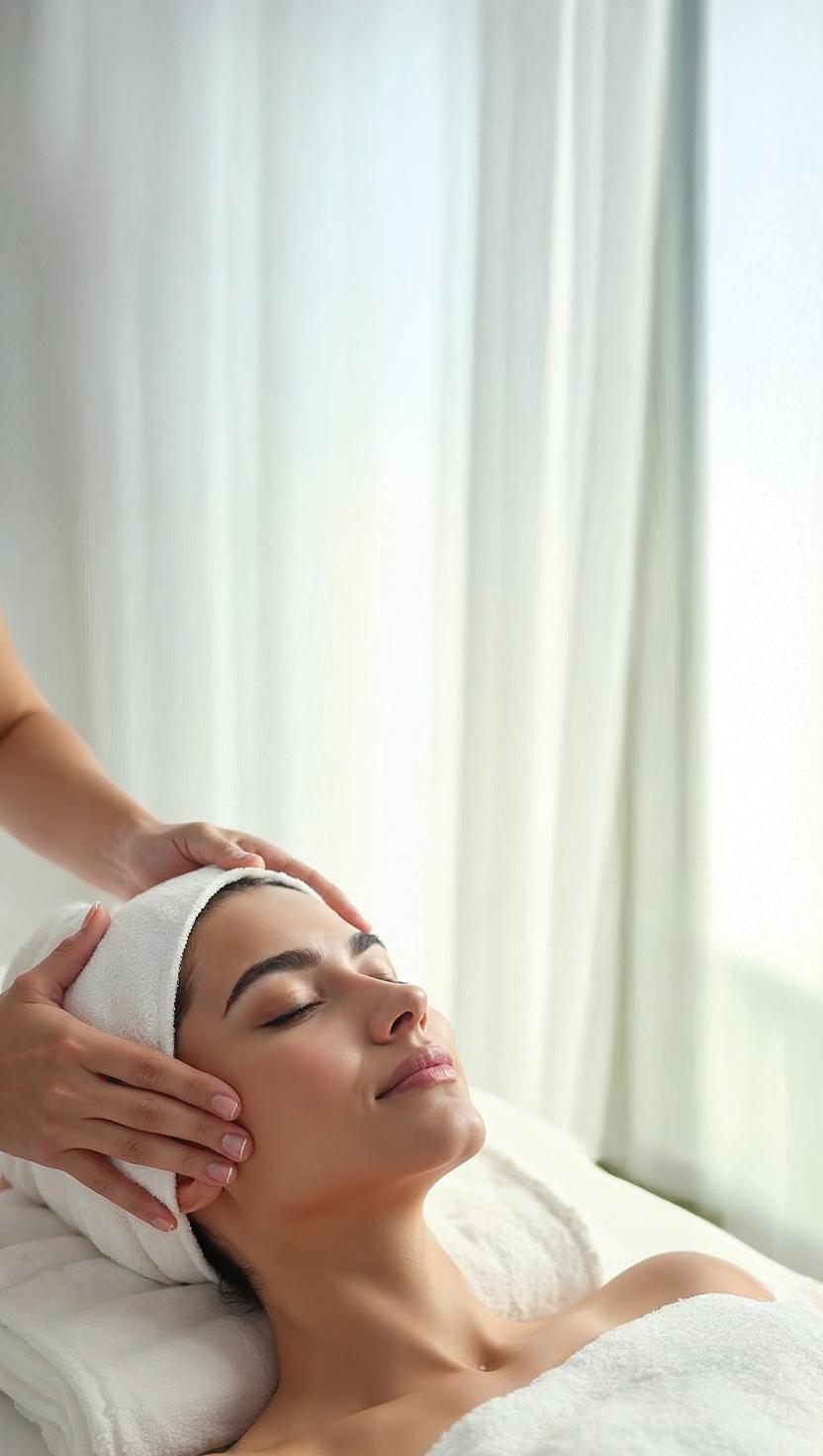
60-minute | QAR 880
A complete anti-ageing journey combining potent ELEMIS actives with signature lifting techniques to contour and restore radiance.

Start with a refreshing welcome drink, then enjoy full access to our pool, gym, and relaxation facilities. Unwind with a 60-minute relaxing massage, followed by a power lunch at Anis Café.
QAR 800 for 2 people.
Advance booking required.

An ancient technique that it is believed to have been in use 2000 years ago in China, as a means to treat certain diseases. Evidence has been found that heated rocks were placed upon peoples’ abdomens to aid them in digestion. Much later native Hawaiians used lava rocks wrapped in leaves for pain relief.
While hot stone therapy has a long history, its modern variance has only been around since 1993. Mary Nelson introduced LaStone therapy, inspirated by the ancient techniques. Unlike other hot stone massages, LaStone Therapy uses both hot and cold stones throughout the massage.
It was LaStone that thrust hot stone massages back into the spotlight and these massages have rapidly grown in popularity. This has allowed for an expansion of different styles and techniques used. Generally these treatments begin with the stones being heated to the right degree so it will not burn on contact with your skin, placed on specific points on your body.
It is best to speak to your therapist before the session about where you might be holding tension in your body. This allows for the stones to be more strategically placed on your body, allowing the heat to penetrate deeper into the affected muscles – they can be placed on your back, stomach, feet, chest, face and even toes if needed.
Hot stone massages are effective at relieving muscle pain, while the deeper state of relaxation found in these massages allows for much better treatment of anxiety and stress.


The word ‘spa’ originates from the Latin salus per aqua, meaning ‘health through water’. Spas were popular in ancient Egyptian, Greek, Roman and Middle Eastern cultures – the ruins of an ancient bath were discovered in Pakistan that date back as far as 4500 BCE.
Hydrotherapy encompasses a wide array of techniques that vary in approach, but only the use of water in the treatments remains consistent. Most involve Jacuzzies and hot tubs, as the hot water helps relax the muscles while the power jets provide massaging effects. Other approaches use ‘contrast hydrotherapy’, which involves moving between a hot water environment, such as a tub or steam room, and ice baths. This stimulates blood flow throughout the body and helps improve circulation.
Hydrotherapy uses water for soothing pains and other ailments, and is effective in the treatment of arthritis, burns, rheumatic diseases, musculoskeletal disorders and more. It is also effective for improving circulation and as a tonic for the nervous system.
While hydrotherapy treatments are rather diverse, generally they include steam rooms, water jets or showers, whirlpools, hot tubs or Jacuzzies, and icy plunge pools. This pairs well with other treatments such as Swedish massage and aromatherapy, and it is not uncommon to find these treatments offered together.



Indulge in the glow you deserve with our Pure Radiance offer. Rejuvenate your skin and senses with a treatment designed to hydrate, brighten, and restore your natural glow. Perfect for a midweek pick-me-up or a special self-care moment. Book now and let your radiance shine through.
• 30-minute body scrub
• 60-minute Anantara massage
QAR 880 per person


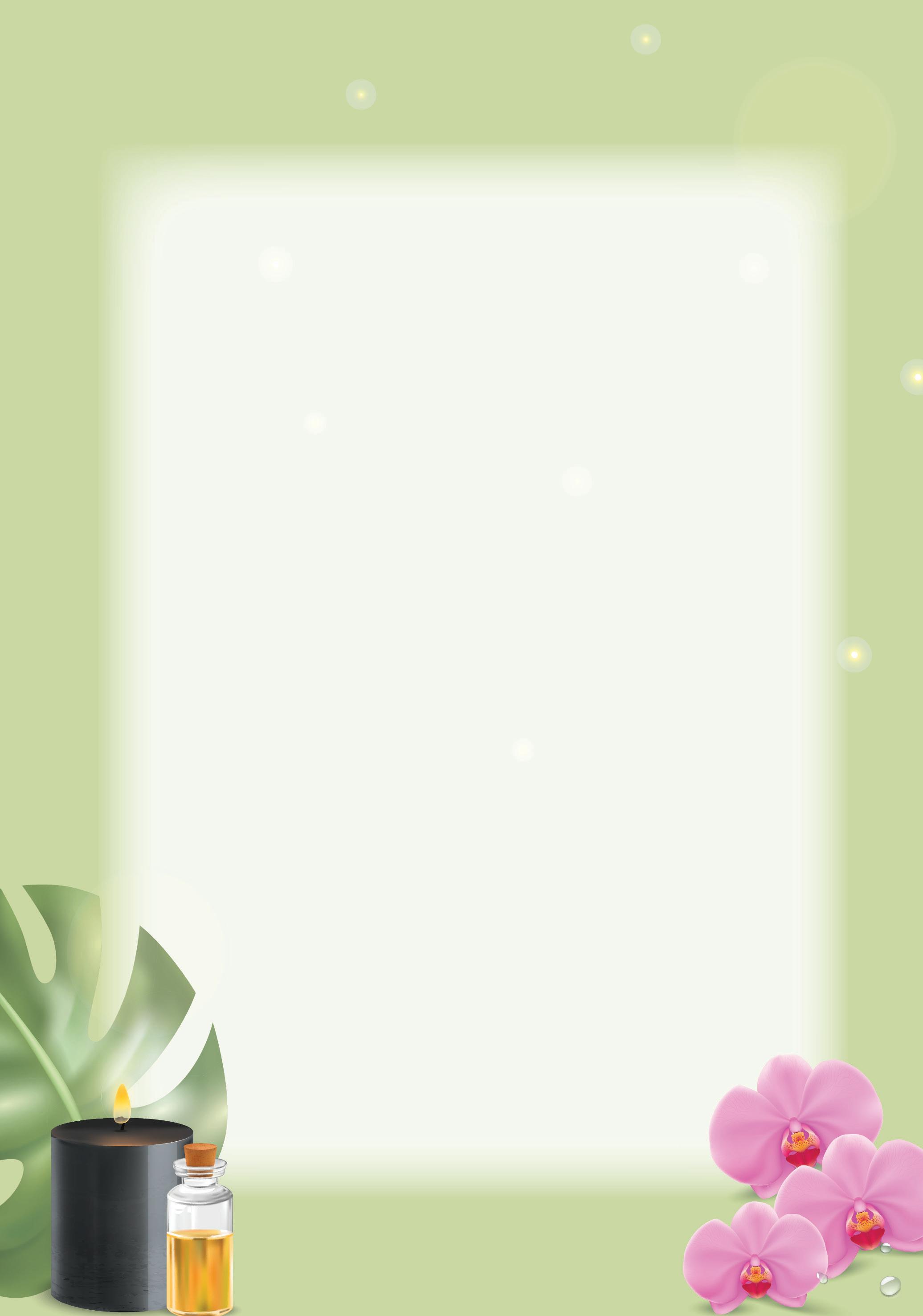
The Swedish massage, also known as the classic massage in many European countries, has a confusing origin. While many think it originated from Sweden, it was in fact believed to be invented by Dutch physician Johann Georg Mezger. He defined this massage practice using five different massage movements and forms.
The first of these forms, Effleurage, consists of smooth flowing strokes, usually towards the heart to help with circulation, that are typically used to apply oils. This is followed by Petrissage, a technique that uses kneading, squeezing, lifting, shaking, wringing and rolling to enhance blood circulation and unknot muscles, improving the healing process.
The final three processes are friction, tapotement and vibration. These include firm circular rubbing motions, rhythmic tapping or percussive movements, and shaking particular muscles. These work by warming up and stimulating the muscles and blood flow, and finally decreasing muscle tension which increases overall body relaxation. The amusing technique of karate chopping your shoulders, often joked about in movies, is actually known as hacking, and while some may think of this as the signature move of the Swedish massage, it is actually Effleurage.



This form of massage is believed to have been invented in India over 2500 years ago by Jivaka Kumar Bhaccha. Bhaccha was a friend of the Buddha, who it was believed had tremendous medicinal knowledge for the time. The Thai massage is known as a dry massage as it does not require the use of oils; furthermore, the patient remains fully clothed throughout the treatment.
A Thai massage therapist uses their hands, knees, legs and feet to move the patient into a series of yoga-like stretches while lying on a padded mat. Acupressure, muscle compression and joint mobilisation are also used during treatment. The pressure, tension and motions created from this help the body by improving blood flow. Thai massages promote relaxation, reduce pain, improve circulation, increase flexibility and increase energy levels.









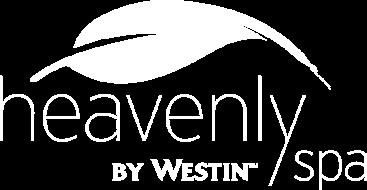

Taking a traditional hammam or bath is popular in the Middle East where bathing is more than just a shower.
There are a variety of types of baths across Middle Eastern cultures, but the most popular are the Moroccan and Turkish baths, which are centuries old, but have mainly remained unchanged. Not only are they relaxing, but also help cleanse and rejuvenate your body.
Moroccan hammam
The Moroccan hammam is a traditional public bath that is very special in Moroccan culture. It deeply cleanses the body using steam and exfoliating beauty techniques that have been used by Moroccans for centuries. However, as it became more popular across the region where most people are conservative, it has become a more private bath, involving the same process, but with just one individual per bath to avoid getting unclothed with others.
A Moroccan hammam is a long bath, typically involving sitting in steam for a few minutes to open your pores and help loosen any dirt and debris buildup, then washed with Moroccan black soap. This is then rinsed off with hot water then you are roughly scrubbed with a scrubbing mitt to exfoliate your skin by removing dead skin. You are then rinsed with hot water again and then you may have another form of a soothing cleansing scrub followed by a final rinse with hot water. Finally, a mud or clay treatment is applied to your body to close your pores and if you wish, your hair gets washed as well. This hammam leaves your skin vigorously exfoliated.



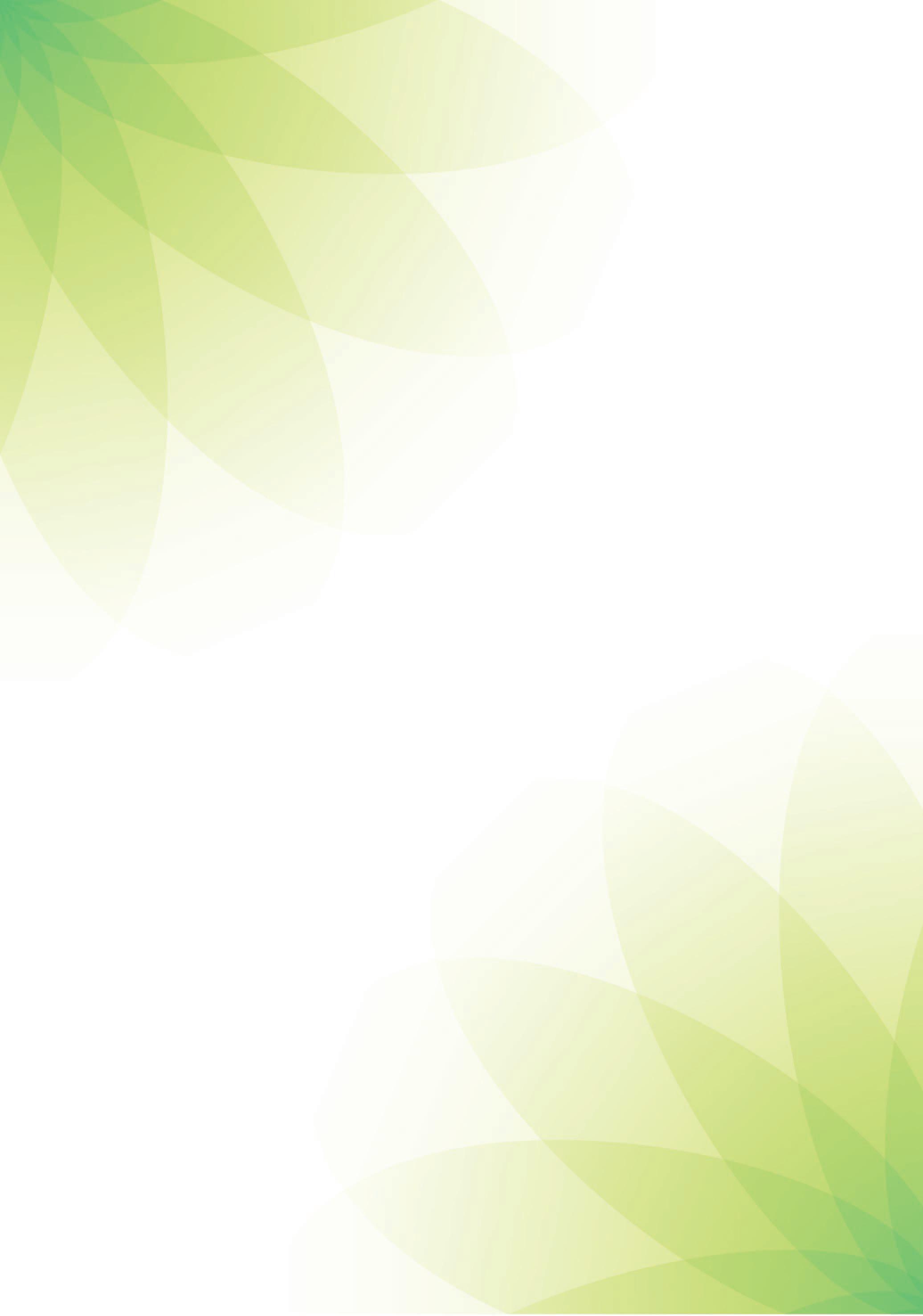


Turkish hammam
The Turkish hammam traditionally begins at a warm section where you can relax and sweat next to a kurna, the small marble basin. Next comes the scrubbing where every inch of your body is scrubbed with a mitt called kese. Once scrubbed, you will lie down on a warm marble slab, called the gobektasi, in a hot section, where you will be laced with a foam-filled cloth for a sudsy massage. Following this rejuvenating experience, most linger in the bath area (either hot or cold) and relax.
Both baths are excellent for relaxation and detoxifying the skin. However, if you wish to be deeply scrubbed, then the Moroccan bath might be preferable, especially as they use the sought-after black soap, which deeply cleans the skin by removing toxins and dead skin cells, making the skin softer and smoother. If you prefer a bath with a massage, Turkish baths incorporate many massage techniques, which help relieve stress and muscle tension by increasing blood circulation. And if you would like to avoid a steam treatment, then the Turkish hammam might be preferable.
Female and male sections are separated in traditional baths. In Qatar, Moroccan hammam is most popular and on offer at many spas and beauty centres. Turkish baths, however, are on offer at a few spas and beauty centres. Please note that every bath can differ from one place to another.
Whether you’re looking for a traditional Moroccan or Turkish hammam, pore over our Spa & Beauty Centres e-guide and make an appointment today.


The use of fragrant oils for healing purposes has been prevalent in many ancient civilisations, and the tradition continues today. However, it was French chemist Rene-Maurice Gattefosse in 1935 who coined the term aromatherapy. Supposedly, while working in his factory there was an explosion that left him with severe burns. He treated these burns with lavender, and upon seeing his miraculous recovery founded the French Society of Aromatic Products.
Inhalation of the scent of essential oils and the absorption of the oils through the skin allows the different plant and flower essences to affect the body, mind and spirit. Many spas offer aromatherapy in conjunction with massage treatments to elevate the experience. Typically the client picks the essential oils to be used, based on the aroma or promised effects (check you are not allergic to any of the ingredients first as they may be in direct contact with your skin). These essential oils will either be directly applied to the body as oil used in the massage or added to a diffuser to be inhaled throughout the massage, creating a relaxing environment.
While many of the healing properties of aromatherapy have not been scientifically proven, it has been shown to help reduce stress and anxiety, and relieve pains.
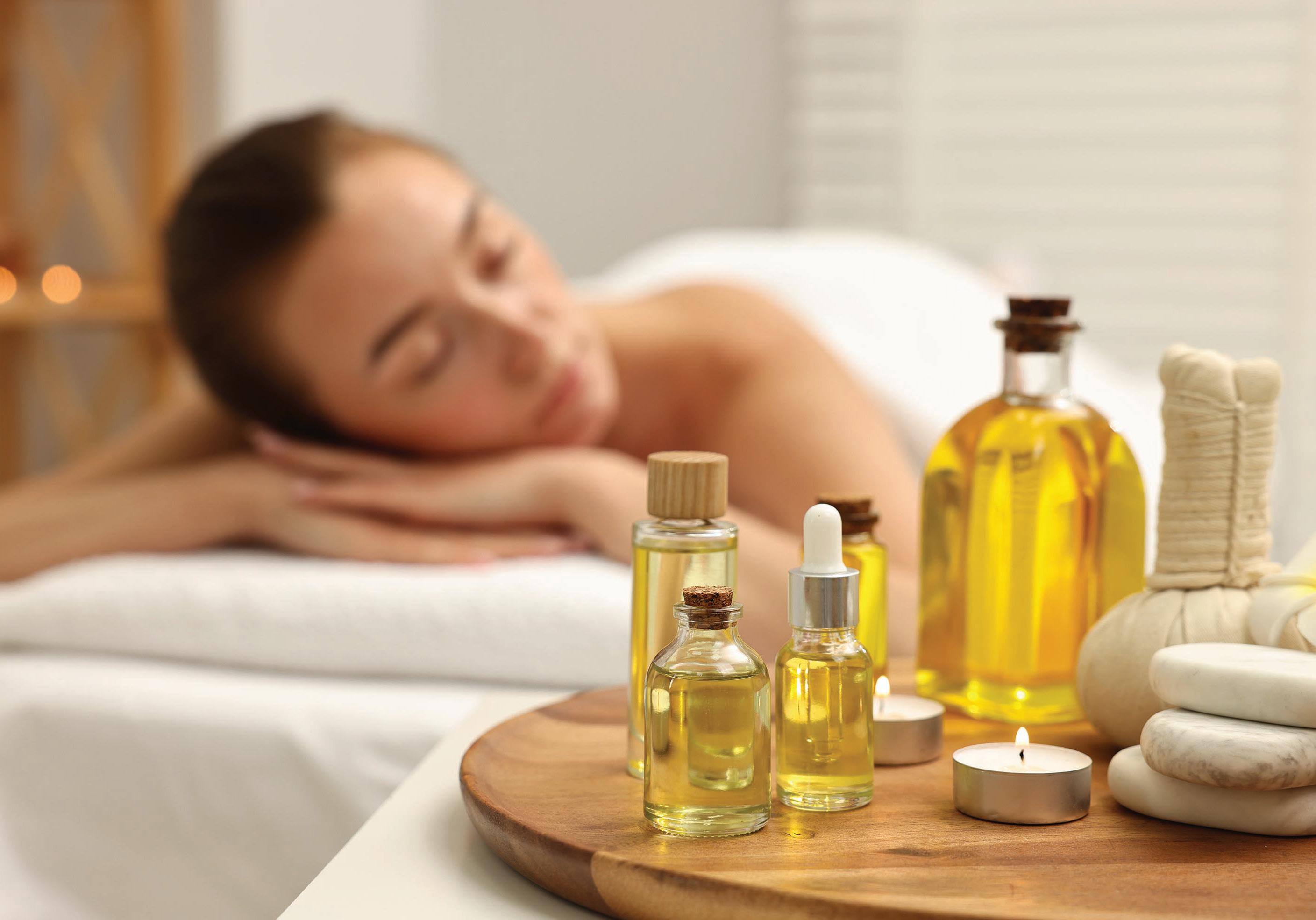

Also known as zone therapy, reflexology is a dry massage that involves the application of pressure to specific points on the feet using thumbs, fingers, and hand massage techniques. The same may be applied to the hands as well.
It is based on a system of zones and reflex areas – energy fields, invisible life force, or Qi – that supposedly reflect an image of the body on the feet and hands. Practitioners believe massaging feet and hands stimulates energy and releases ‘blockages’ in specific areas that cause pain or illness.
Practices that resemble reflexology have existed in history, particularly in China and Egypt. Reflexology was introduced to the US in 1913 by William H Fitzgerald, MD, an ear, nose, and throat specialist, and Edwin F Bowers. According to Fitzgerald, applying pressure had an anesthetic effect on other areas of the body. It was later modified in the 1930s and 1940s by nurse and physiotherapist Eunice D Ingham, who claimed that the feet and hands were especially sensitive, and mapped the entire body into ‘reflexes’ on the feet, renaming ‘zone therapy’ as reflexology. Reflexologists today use Ingham’s methods, or similar techniques developed by the reflexologist Laura Norman.
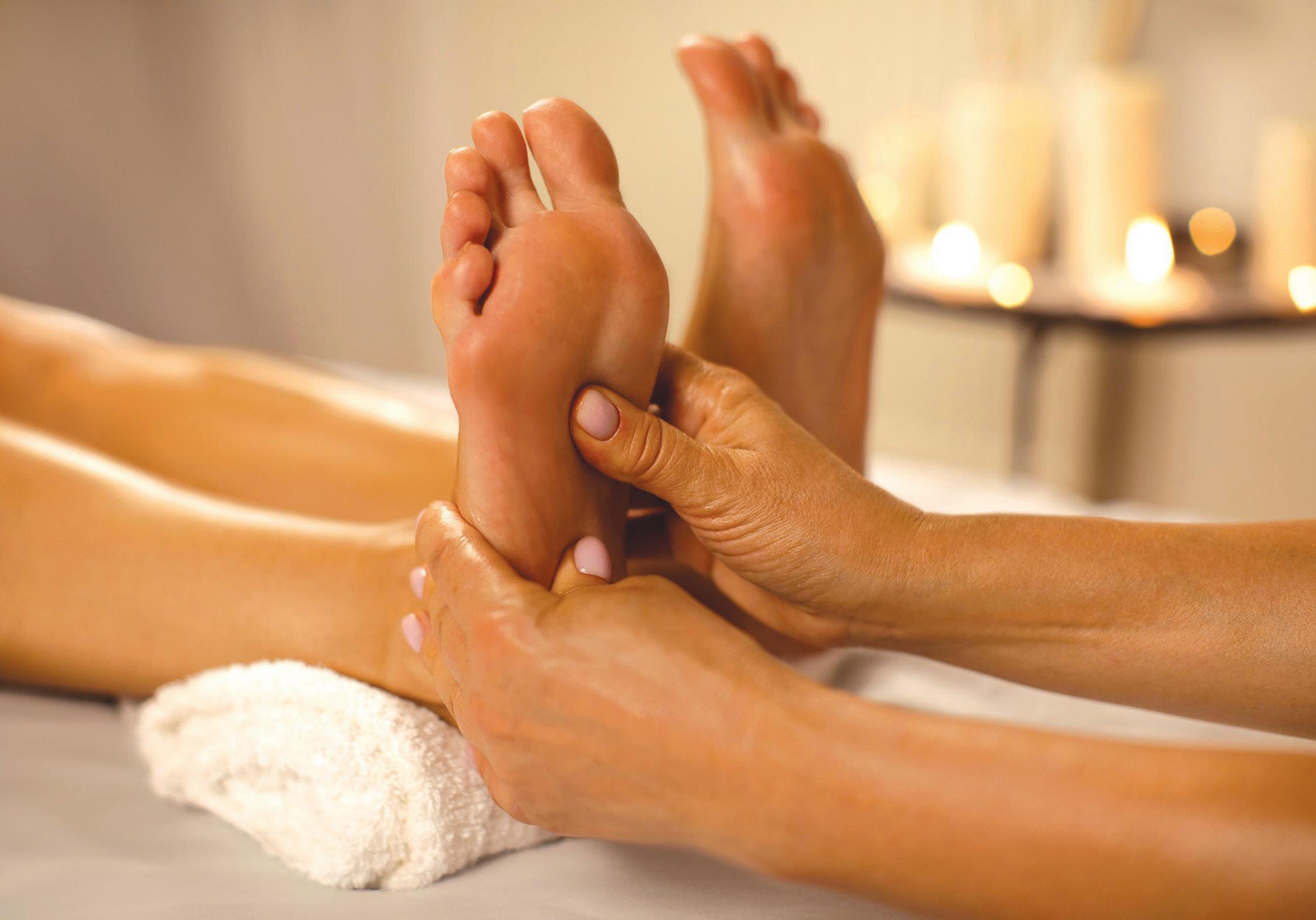

Saunas are small rooms, often made with wood, and heated 65°C–90°C. Some saunas have rocks inside that absorb the heat of the room; water can be added to these to create steam. Using saunas is easy but there are a few things to note. When entering, try to be quick as they are airtight and opening the door will allow the heat to escape. Bring a towel to sit on once you are inside the sauna, and when selecting your seat remember that heat rises, so the elevated seating areas will be hotter – experiment with this to find what temperature is right for you. It is recommended that you spend no longer than 10 minutes in the sauna. Be mindful that this is a shared space and that it is polite to check with others before changing the temperature.
Saunas have a long history dating back thousands of years to Finland where simple caves were used. The reason they have managed to endure the test of time is the health benefits they have. It has been suggested that saunas can ease muscle and joint pain, reduce stress levels, improve circulation, treat certain skin conditions and reduce asthma symptoms. Given the intense environment they create they are not for everyone. If you have any underlying medical conditions or are pregnant it is worth checking with a medical professional first.

Similar to a sauna, but where a sauna is usually dry, a steam room gets it heat from the humidity achieved using a generator that pumps steam into the room. Steam rooms are typically only heated to around 43°C, but operate at around 100% humidity levels.
The intensity of the humidity often makes steam rooms feel as though they are much hotter than saunas. Enter the steam room quickly to prevent the moisture escaping and again sit on a towel. Steam rooms, like saunas, can dehydrate you quickly so it is important to ensure you are hydrated before, during and after your time in the steam room.
Typically the time you spend in the steam room is 10–15 minutes; it is not recommended that you stay any longer. Although steam rooms and saunas are similar, they do offer differing health benefits. Steam rooms are excellent at alleviating congestion, lowering blood pressure, improving circulation, relieving the symptoms of bronchitis, and relaxing muscles and the mind. Furthermore, the steam allows your pores to open and helps to clear any dirt and debris build-up, leaving you with refreshed, healthy and clean skin.
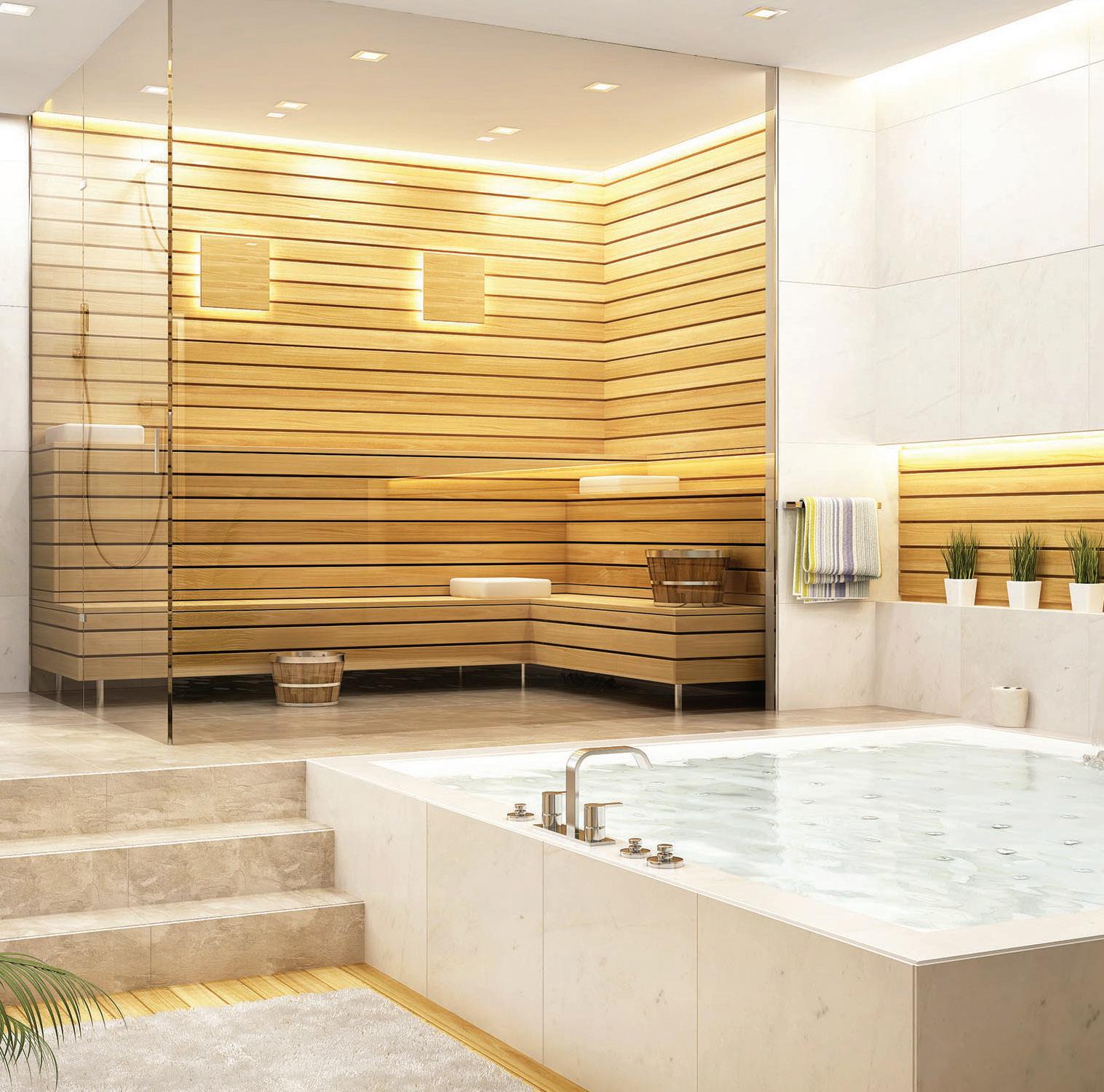



Colour therapy or ‘chromotherapy’ can be traced back thousands of years, as even the ancient Egyptians practiced using light for healing.
This type of therapy believes that the different wavelengths of colours can have positive effects on the body. More recently the benefits of these colours have been identified as:
• red – vitalising and giving energy • green – calming and restorative • white – rebalancing the senses • yellow – inspiring hope and happiness • blue – restful and restorative • orange – fresh and invigorating • magenta – lowering anxiety and increasing creativity.
The effects of colour on mood are well documented, and colour therapy is effective for improving physical and emotional wellbeing.
Another form of colour therapy comes from the traditional Indian medicine ayurvedic. Here it is believed that there are energy centres throughout the body called chakras, and that when these become blocked we start to feel unwell. Colour therapy is believed to help with unblocking these chakras, as each colour is associated with a separate chakra.
While these two methods might differ in what effect each colour may bring about, the treatments are incredibly similar. A colour therapist may use coloured light, gemstones, candles, fabrics, bath treatments or lenses in order to obtain certain healing effects; these are usually done alongside other treatments.
Some spas may have more dedicated facilities; these typically include colour therapy rooms, whereby the lighting can be adjusted and cycled for optimum healing. Alternatively, spas may have masks that emit light directly onto your skin to apply the desired effects.
While the science of colour therapy’s healing properties needs further research, it has been show to provide a thoroughly relaxing experience, decrease stress and overall improve mental wellbeing.

Recognising the increasing demand for complementary and alternative medicine, the former Supreme Council of Health gave official approval to some of these practices in Qatar in 2016. The Qatar Council for Healthcare Practitioners (QCHP) at the Ministry of Public health is responsible for authorising, licensing and monitoring healthcare practitioners in the country. QCHP states that the term ‘complimentary medicine’ has been adopted instead of ‘alternative medicine’ to ensure that patients receive complementary treatment in addition to conventional medical treatment. The list of regulated disciplines includes Hijama (wet cupping), chiropractic, homeopathy, ayurveda and acupuncture.
The regulatory framework standardises CM practices so that only licensed, qualified practitioners will be issued a medical licence and allowed to practice in Qatar. It also provides a legal framework for CM to ensure that the benefits of these practices can be enjoyed without unnecessary risks.



Recent studies have concluded that cupping is a safe treatment that can restore balance between positive and negative forces, remove disease-causing factors, and promote blood circulation.

Cupping is an ancient, holistic method for treatment of a variety of diseases. It is quickly becoming a popular therapy, generating new interest for health promotion, prophylaxis and treatment of a variety of diseases around the world. Although there is little evidence to justify the use of hijama, many believe in it as a method of alternative or traditional therapy or treatment. Traditionally, cups were made of glass, metals or even bamboo.
Other names for cupping therapy include cup therapy and suction cup therapy. In the Arab world, it is known as hijama.
Cupping therapy is not new. There is a very long history of cupping and it has remained an integral part of medicine for thousands of years. The historical descriptions of cupping therapy were found in ancient human civilisations of the Eastern and Western world.

Cupping has a long and rich history in the Arab and Muslim world. The Ebers Papyrus – one of the oldest medical textbooks – mentions the use of cupping by the ancient Egyptians for treating various ailments such as menstrual imbalances, weakened appetite, fever, vertigo and pain. Moreover, drawings of cupping were also discovered on the Temple of Kom Ombo near Luxor. Kom Ombo is regarded as one of the most ancient cities of Egypt.
In the ancient Islamic world, the term used for cupping was al hijamah and Prophet Muhammad (PBUH) said to his followers 'indeed the best of remedies you have is hijamah'. Famous Islamic physicians such as Al Zahrawi (936 – 1036 CE), Ibn Sina (980 – 1037 CE), and Abu Bakr Al Rizi (854 – 925 CE) described cupping sites and illustrated cupping with diagrams in many of their literature.
Cupping also has history in Greece and other European countries. In ancient Greece, Hippocrates – a physician by profession and who is regarded as the father of modern medicine – used cupping therapy for treating internal diseases and structural problems. Hippocrates recommended the use of cupping for treating ailments such as angina, menstrual irregularities and other disorders in his guide to clinical treatment.
The practice of cupping spread to many European countries between the 14th and 17th centuries, particularly during the Renaissance era. It was regarded as the most popular treatment for arthritis and gout in Italy during this period. Throughout the



18th century, cupping therapy was practiced by a great majority of European doctors who used it for the treatment of common cold and chest infections. With the introduction of the newly established scientific model of medicine in the late 18th century, the popularity of cupping lessened.
Methods of cupping
Hijama is a type of wet cupping, which involves using a cup to pull the skin into traction, resulting in a laceration of the skin with the drawing of blood into the cup. A cloth soaked in rubbing alcohol is ignited on fire and put inside the cup to produce a vacuum. Cups, which can be glass, plastic or silicone, are then placed on your back, stomach, face, legs, feet, arms, hands, knees, or any other therapeutic region on the body. When placed on the back – the most common body part for cupping therapy – cups are placed directly on top of meridian lines. The cup sucks the skin into it as a result of the suction. The ensuing suction pushes the blood deep within the body to the surface. Healing occurs as a result of the increased blood and energy flow. Cupping therapy is traditionally performed in groups of four, six, or ten cups. Typically, the cups are left in place for 5 to 20 minutes.
Most common cupping methods:
Dry: Your practitioner heats the inside of each cup. The traditional method involves setting an alcoholsoaked cotton ball aflame. The heat sends oxygen out of the cup, creating a vacuum. A more modern approach involves using a suction device to remove air from the cups. The vacuum force pulls your skin up into the cup.
Running: This is like dry cupping. But before beginning, your practitioner will apply lotion or oil to

your skin. Once they place the cups, they’ll gently move them in different directions over the affected area of your body.
Bleeding: Your practitioner uses a needle to lightly puncture your skin before placing the cups. This allows for the release of toxins through the suctioned blood captured in the cup.
Other types of different cupping methods include weak/light, medium, strong, moving, needle, moxa/ hot needle, empty/flash, herbal, fire and water.
Cupping may ease symptoms of:
• Arthritis, including rheumatoid arthritis
• Back pain, neck pain, knee pain and shoulder pain
• Asthma and other breathing issues
• Carpal tunnel syndrome
• Gastrointestinal (GI) disorders like irritable bowel disease (IBD)
• Headaches and migraines
• High blood pressure (hypertension)
Other benefits of cupping:
• Faster pain management
• Release of chronic muscle tightness
• Improvement of blood circulation
• Cure chronic fatigue syndrome
• Relief of lung disease
• Stimulating the release of toxins from tissues
• Helping with varicose and spider veins
• Relieving digestive problems
Drawbacks of hijama
Cupping is essentially safe if performed by a competent expert. However, the following adverse effects may occur in the region where the cups come into contact with your skin:
• Mild discomfort
• Burns and bruises
• Skin infection
• Bloodborne infections such as hepatitis B and C
In Qatar, cupping therapy is widespread and can be found in medical centres as well as spas and beauty centres. There are also centres that are specifically dedicated to cupping therapy. In addition, there are also licensed cupping therapists who provide home services. Wherever you go for cupping therapy, make sure they are experts and licensed by the Ministry of Public Health (MoPH).
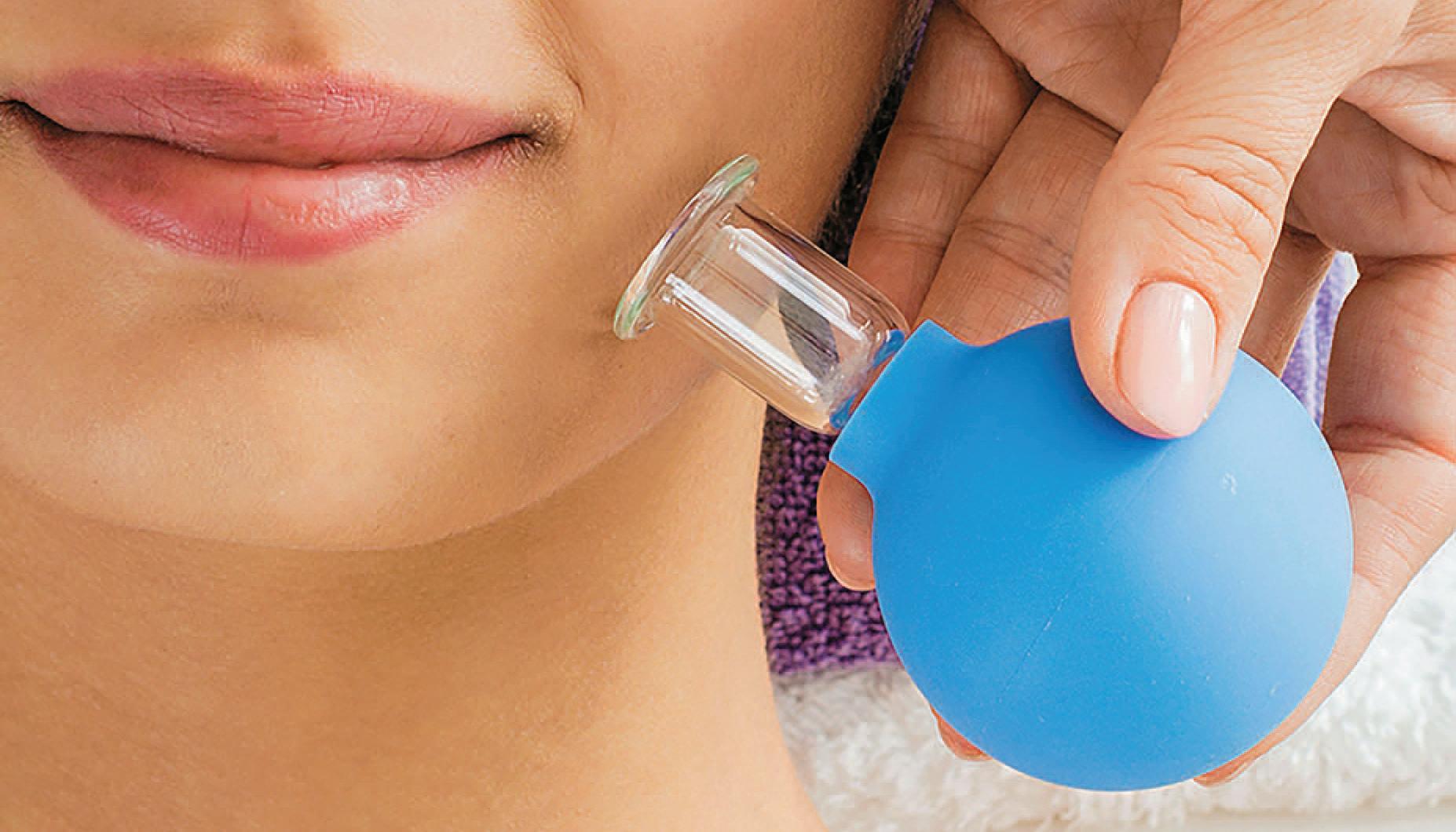

Perhaps no one is more deserving of rest and relaxation than an expecting mother. Many spas can accommodate pregnant women, and even offer specific treatment packages.
The spa experience may be a little different while pregnant to avoid any risks. These involve providing special massages that use bean bags or adapted chairs that mean you do not have to lie on your stomach. However, you may find that these massages are not offered to women in the early stages of pregnancy, and often require waiting until at least the second trimester.
Furthermore, certain aromatherapy ingredients can cause irritation while pregnant as the skin often becomes more sensitive. It is often best to ask your massage therapist or doctor on what to avoid, or request that the therapist uses only plain oils. Head, shoulder and foot massages, mani-pedis and facials are recommended as they are an excellent way to relax and relieve any aches and pains.
However, certain facilities, mainly saunas, steam rooms and hot tubs, be avoided as they have a high risk of causing overheating. Cooler facilities are more suitable, like a pool, which can still provide ample relaxation.



While many treatments are safe, checking with your doctor that they are right for you is always advised, so you can make an informed and healthy decision.




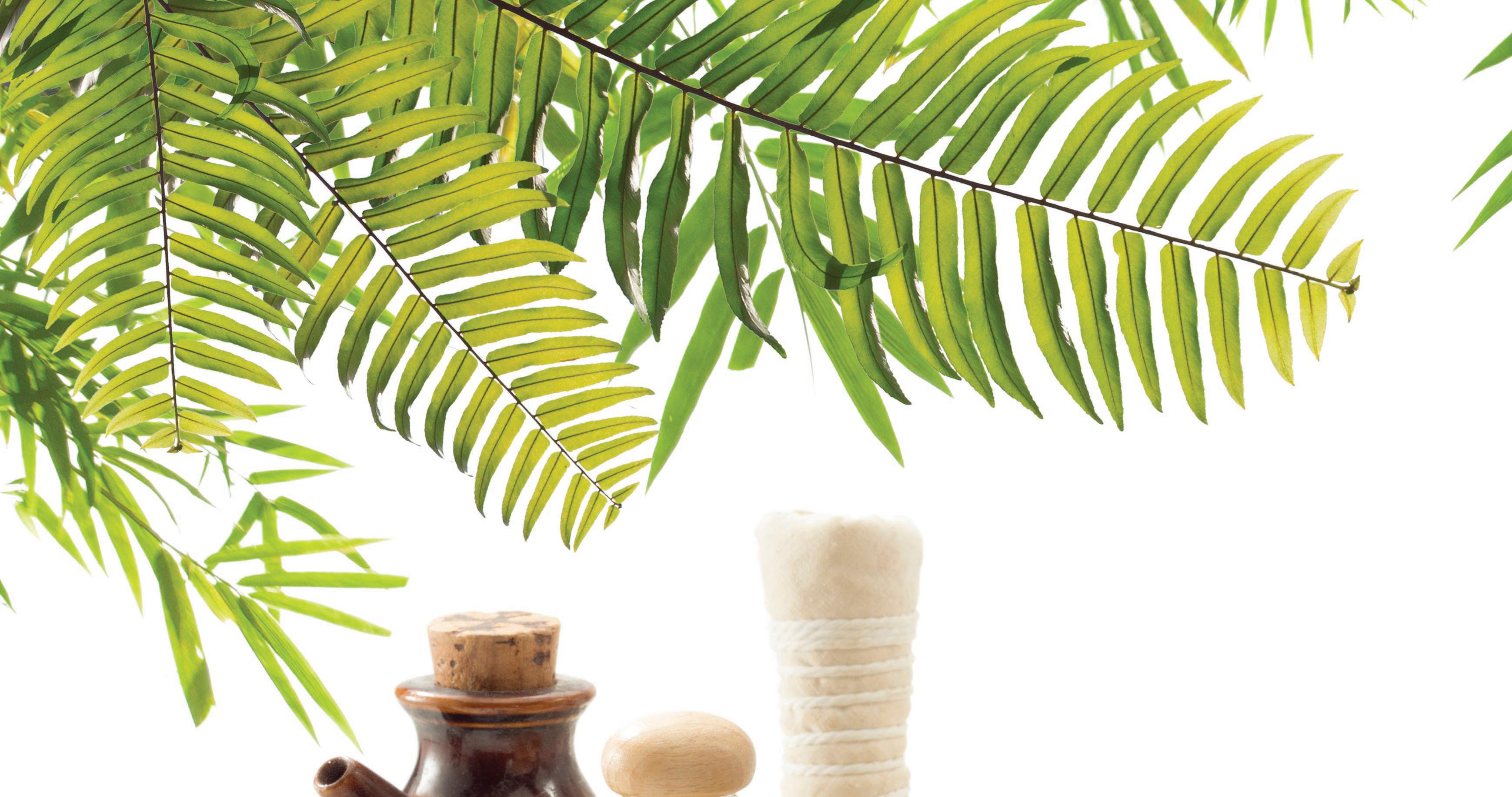
While spas are a great getaway from the stress of everyday life many do offer at home solutions that help bring your relaxation home with you. While these are obviously no replacement for the spa experience many can help bring some of the same mindfulness and peace to your home. There are a variety of ways this can be achieved and many of them are fairly simple to do and require very little effort.
One of the easiest ways to have a relaxing spa like experience at home is creating your own hydrotherapy experience. It is easy to do as all you really need is a nice warm bath to start with. To really create that spa experience, however, it is recommended you pick up some candles to create an aromatic experience to help relax. Many
spas in Doha sell candles or other products that create relaxing aromas that will really elevate the experience to spa like level. Other products can be found to apply to the water that add essential oils, these products are designed to treat your skin and elevate the relaxation experience. Examples of these include various bath bombs, foam and salts. Furthermore, you can also acquire some essential oils and other spa products that can be applied to your skin after your bath to really refresh your skin leaving you incredibly relaxed. This sort of at home treatment is ideal for alleviating any skin conditions, bring about relaxation of both the mind and aching muscles and even help bring about a good night of sleep.




Another excellent way to create a spa experience is to create a space dedicated for relaxation in your home. This could just be a small area in your bedroom or really any unused space in your house. A simple way make it feel like a spa setting is visualise your favourite spa and try to decorate it as such, this could be with cushions, blankets, crystals and even buying some warmer lighting can add to this effect. While this may seem like a surface level change it can help foster an environment that is easier for you to relax in. To really improve upon this, you can draw on elements from colour therapy to decorate or even light this space according to the colours used to draw out certain effects. Further enhancements can be made
by adding an element of aromatherapy using essential oils and various incenses that can be purchased from many spas across Doha. These products really help replicate the sensation of being at a spa and help create that same aura of relaxation at home. Some of these spas even allow you to purchase the robes they give you, allowing you to have that soft robe for at home use. With this new space you can really practice mindfulness however you would like. This can be through practicing meditation and yoga or simply sitting back and reading book. Regardless of what you do with the space it should hopefully help bring some of the relaxation you can get from a spa home with you.



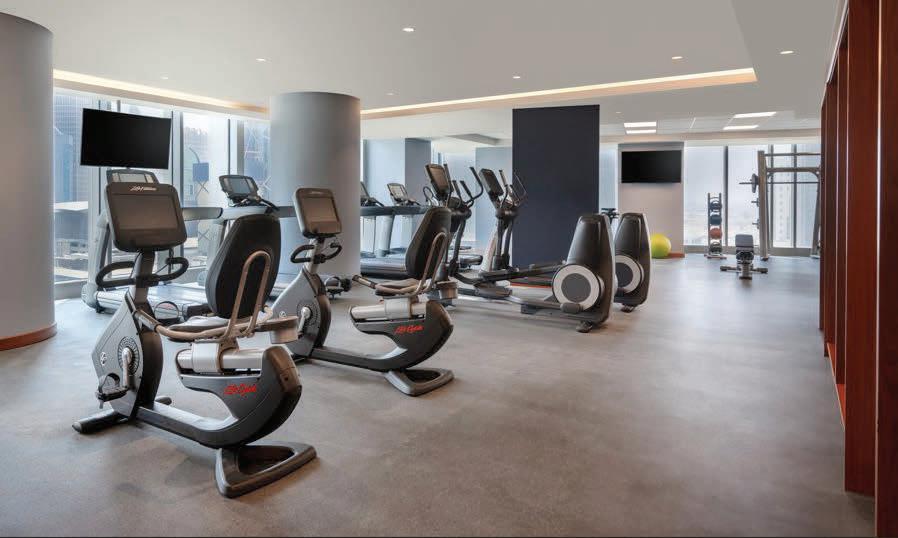








*The personal training benefit is included when the additional personal training package per person is added to the membership.


Step into a realm of relaxation as you indulge in Banyan Tree’s exclusive day pass, granting you access to our upscale health club, swimming pools, steam room, sauna, and Jaccuzi.
Adults Day Pass
Weekdays: QAR 100 | Weekends: QAR 150
Kids Day Pass
Weekdays: QAR 50 | Weekends: QAR 100


Operating hours: 10 am to 10 pm
Valid only on the same day until closure time.
R8 Indoor Pool is only allowed for adults aged 16 and above.
Day Pass fees must be fully paid in advance at Healthclub Reception, oor R1.
For details, please call 3990 0281








